























The new Dewar’s 12 Year Old is double-aged in hand-selected 1st-fill bourbon casks to create a rich, smooth, perfectly balanced flavor profile that continues to win awards from the world’s top whisky critics. Try it and you’ll understand why.






















 Top: Austin Cook, Gaby Lopez, Andrew Landry Middle: Brooke Matthews, Taylor Moore, Maria Fassi
Bottom: Dicky Pride, Stacy Lewis, David Lingmerth
Top: Austin Cook, Gaby Lopez, Andrew Landry Middle: Brooke Matthews, Taylor Moore, Maria Fassi
Bottom: Dicky Pride, Stacy Lewis, David Lingmerth
We tip our hat to the Stephens Brand Ambassadors on the PGA Tour, the LPGA Tour and the PGA Champions Tour. We are proud to support these players because their values and work ethic exemplify the culture of our firm. Each of them, along with the University of Arkansas golf programs have made golf an indispensable contributor to the quality of our state and our country.
The sense of warmth and camaraderie from dedicated staff. The thrill of becoming awestruck as you arrive at a fabled destination for the first time. The joy of celebrating life, with indulgent cuisine.


It’s the personal experiences that will last a lifetime.





EXQUISITELY CRAFTED CUISINE. CURATED TRAVEL EXPERIENCES. SMALL SHIP LUXURY.




“I have never seen anything like this—any place. Period.”



—Pete Dye



“It’s going to be a hell of a course.”
—Herb Kohler



















Publisher & Co-Founder
Matthew Squire
Editorial Consultant
Bruce Wallin
Art Director
Matthew Halnan
Editors
Robin Barwick (UK)
Shaun Tolson (US)
Head of Advertising Sales
Jon Edwards
Sales Director
Scott Verel
GM, Kingdom
Joe Velotta
Content & Design Associate
Phil Grundy
Founding Director
Arnold Palmer
Photography
Getty Images, Evan Schiller
Special Thanks & Contributors
Steven Alker, Lavinia Biagiotti Cigna, Heinz Beck, Esme Benjamin, Ted Brady, Loredana Capobianco, Cary Cozby, Full-Time Travel, Michael Gartenlaub, Justin Leonard, Robert Rock, Scottie Sche er, Randy Smith, Riccardo
Tirotti, Mark Townsend, Valentina Virgili, Shivani Vora, Anne Walker, Jane Wandmacher, Michael Williams, Roddy Williams, Rose Zhang
Subscriptions
Order online at: kingdom.golf/the-magazine and receive special subscriber o ers
Or email: jv@kingdom.golf
Enquiry Addresses
Advertising ms@northandwarren.com
Editorial rb@northandwarren.com
Commercial Enquiries ms@northandwarren.com
646-970-3755 | kingdom.golf
North & Warren
President & Partner
Jay Meyer
VP, Marketing
Ashley Burke
Special Projects Director
Emily Poppert
Marketing Manager
Isabel Brandl
Operations Manager
Mandee Klenk
N&W Partnerships
Christian Poppert, Jana Robinson, Mark Cooper, David Van Sicklen, Tori DeClaris
Founders
Matt Carroll, Nick Van Sicklen
Cover Image
Marco Simone Golf & Country Club, host of this year’s Ryder Cup in Rome, Italy

Photo: Jacob Sjöman
Socials Visit
Published by 7324 Gaston Ave, Ste 124-451; Dallas, TX 75214
© 2023 North & Warren, LLC. Reproduction without permission is prohibited. The articles appearing within this publication reflect the opinion of their respective authors and not necessarily those of the publisher. The contents of advertisements and advertorials are entirely the responsibilty of advertisers. No responsibility is taken for unsolicited submissions and manuscripts.
Newsletter
Subscribe at kingdom.golf/the-turn
Kingdom magazine was first available to friends and associates of Arnold Palmer, and members and guests of his designed and managed courses. Now it is available at distinguished private clubs and for discerning golfers everywhere.
Printed in the USA
















I cannot believe we are halfway through 2023 already! There are three men’s majors behind us—and nearly four by the time you read this—and the Ryder Cup is already on the horizon. Time flies when you are having fun, although I cannot help wondering if I am in the wrong job: Kingdom’s editorial team enjoyed a fantastic early summer visit to Rome—working hard on our Ryder Cup preview editorial, they assure me—and I believe the team enjoyed the golf course at Marco Simone almost as much as the Italian food and wine!
As the Ryder Cup approaches, our tournament focus will be shared with Kingdom’s own major event—The Kingdom Cup—which will once again be played on the incomparable Hilton Head Island. The dates are September 21-24 and you can find more information about the Kingdom Cup in this issue or by visiting kingdom.golf. We are really excited to be returning to Hilton Head and please consider this my open invitation for you to join us!
I am also excited that we secured exclusive interviews with two of the hottest names in golf for this issue: Rose Zhang (p100) and Scottie Scheffler (p76). When we first connected with Rose to discuss our ‘Future of the Game’ section (p99), Rose was still an amateur and had not yet won her record second NCAA individual title. It seemed like every time we connected, Rose had taken another giant leap into global stardom. She is already a shining ambassador for the sport we all love, and Rose is a star of the present and the future. The expectations that surround Rose are extraordinary, yet we are so impressed with how she takes it all in her stride.


Lastly, do check out our new “Kingdom Clubhouse,” which begins on p156, where the Kingdom team and I have personally recommended some first-class products and experiences. Oh, and look for one of Arnold’s favorites too!
Have a great summer,














68 Steven Alker’s Ascent
A bittersweet victory at the Insperity Invitational continues the remarkable rise of a journeyman golfer
Ryder Cup
76 Scottie Scheffler
The making of a World No. 1 and match-play master
84 Made in Italy

Roman heritage runs deep at Marco Simone
88 When in Rome
Discovering the essence of the Eternal City
94 Winning Away
It’s been 30 years since the USA won in Europe
Future of the Game
100 Rose Zhang
The rising star of world golf tells Kingdom how she’s trying hard to stay grounded
108 How We Play
What’s happening on the ground, from course designs to how we navigate them
116 Ball and Beyond
The long and short of the golf-ball debate and new advancements in gear


122 Greener Greens
The Waste Management
Phoenix Open epitomizes pro golf’s push for sustainability









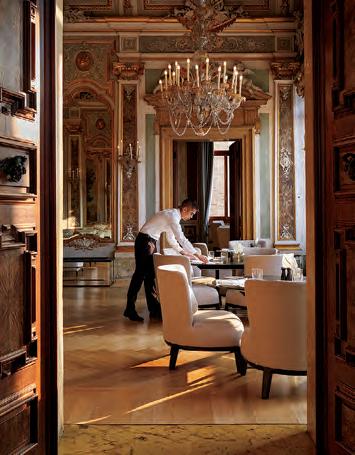



September 21—24, 2023
A golf tournament like no other
The second annual Kingdom Cup will be a celebration of great friends, golf and luxury island lifestyle.


In collaboration with Hilton Head Island, Kingdom will once again bring top names in golf and entertainment together with distinguished guests to enjoy the beauty of the island and incredible golf at Wexford, an Arnold Palmer Design course.


ForDetails&Tickets:Kingdom.golf/cup
Presented by
Reese Moore Photography





Struggling to keep your business compliant and competitive in changing times? Navigate business challenges with the assurance that comes from Insperity’s unmatched HR service and support.


Whether you need help keeping up with evolving labor laws, attracting and retaining diverse talent in a tight market, leading remote teams or overcoming some other HR obstacle, you can move forward with Insperity behind you.

Bethpage Black, perhaps the most prestigious muni in America, will host the next Ryder Cup, in 2025. The Long Island course was set up long and relentless for two past U.S. Opens, yet for the Ryder Cup we might see a different side to its nature. If the home team thinks it can beat Europe on the greens (a strategy that has worked before), then the notorious Bethpage Black rough could be cut back. One thing for sure is that Americans like winning on Bethpage Black, taking home the titles in all five tour events here: Tiger Woods (2002 U.S. Open), Lucas Glover (2009 U.S. Open), Nick Watney (2012 The Barclays), Patrick Reed (2016 The Barclays), and Brooks Koepka (2019 PGA Championship).



David McLay Kidd is working on what promises to be another showstopper in central Nebraska—this one at GrayBull, the latest addition to Dormie Network’s growing portfolio of private clubs. Encompassing one-third of GrayBull’s 1,800 total acres, the underconstruction course will meander between and across vast sand hills that can stretch as high as 100 feet. Tapping into his Scottish roots, McLay Kidd is deftly molding the site, building contours that he hopes golfers will use to their advantage. Every green complex, for example, will feature backboards, kicker slopes, side slopes, speed slots and run-ups. “I’m starting with an extremely compelling landscape,” McLay Kidd says, “so we’re throwing chocolate drops and sprinkles onto something that’s already super cool.”

Since 1958, Southern Hills Country Club has established itself as a go-to venue for major championships. To commemorate this heritage, the Tulsa club recently awarded honorary memberships to all living golfers who have won majors there:

Dave Stockton (1970 PGA Championship)
Raymond Floyd (1982 PGA Championship)
Nick Price (1994 PGA Championship)
Retief Goosen (2001 U.S. Open)
Tiger Woods
(2007 PGA Championship)
Alex Cejka
(2021 Senior PGA Championship)
Justin Thomas (2022 PGA Championship)

Southern Hills also boasts a long history of hosting amateur national championships, dating back to the 1946 U.S. Women’s Amateur won by the great Babe Didrikson Zaharias. The U.S. Women’s Amateur will return to the venerable Tulsa club in July 2024.



There has never been a better time to visit the famous Arnold Palmer–designed Dom Pedro Victoria Golf Course on Portugal’s spectacular Algarve coast. The star attraction in the golf hotbed of Vilamoura, the Victoria course borders the just-renovated Anantara Vilamoura
Algarve Resort (in background), where upgrades include new luxury suites and separate family and adult zones. The resort’s 20 new Signature Suites come with Anantara’s exclusive butler service, so there’s nothing to worry about other than your golf score.


Work is underway on a new nine holes at the stunning Fox Harb’r Resort in Nova Scotia.
The ambitious project is seeing the Canadian resort separate its existing 18 holes into a links nine and a parkland nine. The new nine holes will be combined with the existing links nine to create a genuine oceanside 18, while a new parkland nine holes— a “Vineyard course”—is also slated for the future, which will ultimately leave Fox Harb’r with two distinct 18-hole golf courses. Course architects Thomas Broom and Doug Carrick are masterminding the new links nine, with the layout scheduled to open in the spring of 2025.


“We’re adding smaller scale pot bunkers, grass hollows, more grass faces usage,” explains Thomas. “We want to feature the rumbles and rolls of the land. We want green contours that leverage the existing topography. We’re taking a wild and windswept look and making it a little more refined, a little more elegant.”
The new routing will capitalize on the beautiful and natural shoreline at Fox Harb’r. Golfers will enjoy panoramic views of the Northumberland Strait from all parts of the course, and one of the holes will even demand that golfers play over a sea inlet.
The golf at Fox Harb’r was special. It soon promises to be extraordinary.

Tee off on the greens with magnificent Caribbean views best experienced at Sandals® Resorts. Enjoy an all-inclusive vacation that features gourmet dining, unlimited premium liquors, and luxury accommodations – not to mention the finest, white sand beaches you’ll ever set foot on.
Choose from four golf courses in The Bahamas, Saint Lucia or Jamaica, two of which are 18-hole championship caliber golf courses, featuring layouts by Greg Norman Golf Course Design. Swing into paradise with complimentary green fees and more when you stay at one of Sandals Resorts premier golf destinations.

|

Tom Watson phoned Prestwick Golf Club in 1981 to ask for a Saturday morning tee time and got through to the clubhouse bar. Ever since Old Tom Morris was founding professional at this Scottish links, Saturday mornings were members only, as the bar lady knew well. Watson, however, was the reigning Open champion and a winner of ve majors by this point. “I don’t care if you’re Sherlock Holmes,” she replied. “You can’t play on a Saturday.”
Watson called longstanding pro Frank Rennie—now retired and a member at Prestwick—who found him a game, and the American guest soon learned that lunch at Prestwick is as important as golf.
Years later, he admitted it was “a rather long and very unsobering lunch.”
“Watson was introduced to the delights of Kummel,” starts Ken Goodwin, Prestwick club secretary. “ e story goes that he couldn’t remember playing the rst six holes at Troon in the a ernoon, yet apparently he played them quite well.” e running order at Prestwick is golf; a drink in the Smoke Room; lunch in the Dining Room; then another drink in the Smoke Room. is last part is when Kummel, or “putting mixture” (because it dulls the nerves), is served. A caraway seed–based digestive served neat or on ice, Kummel emerged from Riga in Latvia, on the shores of the Baltic Sea, in the
mid-19th century and became popular as an a er-dinner drink in the UK’s gentlemen’s clubs.
Beyond Prestwick, Kummel is not widely served these days, but it still brings warmth to the Smoke Room as a bracing Scottish a ernoon recedes into twilight. “It has been said that at one time, a third of all Kummel drunk in Scotland was drunk at Prestwick Golf Club,” says Goodwin.
Bartenders at Prestwick serve it chilled, in a shot glass lled to the brim. It might spill on your ngers, hence its other nickname, a “sticky.” But don’t wash o that stickiness: As Watson discovered, if you’re playing a erwards, a little Kummel on the ngers helps with your grip. —robin barwick

Tom Watson, the story goes, couldn’t remember playing the first six holes of his afternoon round, thanks to a shot or more of Kummel.Photo: Stuart McIntyre, taken for Kingdom at Prestwick GC

Azimut calls it “three decks + one,” and the renowned Italian yard has created a stunning cascade of four decks, with a half-raised aft deck expanding the conventions of the triple-decker. The Trideck is the flagship of Azimut’s Grande series, and it has been touring leading boat shows this year. The Grande Trideck also sets the standard for Low Emissions in 2023, with Azimut guaranteeing a reduction in consumption levels and emissions of at least 20 percent.


Ever since Leonardo da Vinci, the Italians have shown a flare for combining high-performance engineering with elegance.












It took six years of research, drawings, experiments, scale models, testing and prototypes to create the Pagani Utopia. The third hypercar to emerge from the workshop of Horacio Pagani, the Utopia is leading-edge yet brimming with old-school power. This Italian masterpiece is built around the finest of German engineering, in the form of the uncompromising Mercedes-Benz V12 turbo engine, hidden beneath the flowing contours of a carbo-titanium monocoque. All 99 were sold before rubber touched tarmac.
The Leonardo AW609 is the world’s first commercial tiltrotor aircraft, so it’s both. It’s dual tiltrotors enable the AW609 to take off and land like a helicopter, and then they “tilt” in mid-air so the aircraft can fly like a conventional airplane, and at twice the speed of a helicopter, at altitudes of up to 25,000 feet. The first prototypes of the AW609 were built back in the 1990s, and reportedly, it is finally close to receiving certification after years of tests and improvements.


Aprilia introduced its original RSV4 superbike in 2009, and it has been an epic ride since. An icon of Italian engineering and performance, the RSV4 in 2023 is still built around a V-4 heart and 217 horsepower but with refined aerodynamics, a bigger displacement 1,099cc engine, a new inverted-style swingarm, advanced Performance Ride Control electronic rider aid package, and an expanded 5-inch TFT dash.
The C68 Allroad is not a road bike as you know it, and nor is it a gravel bike, but it rides between the two as a premium bike designed for endurance and versatility. This is a bike for the cycling adventurer, for riding a long way from home, into unfamiliar territories, for journeys that might continue past the end of the road.
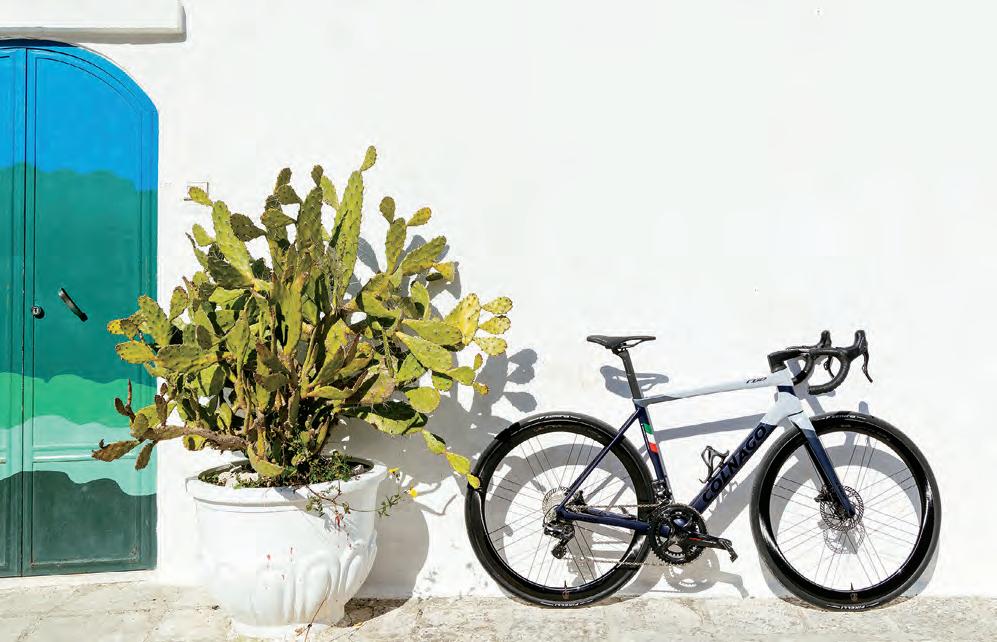


$1,100
$185
$699


Paolo Scafora learned artisanal shoemaking from his father, Gennaro, who handmade shoes from his workshop in Naples, Italy. As a young man, Paolo broadened his horizons and expertise in Milan before traveling the world and absorbing an array of different shoemaking traits and conventions. He eventually returned to Napoli to establish Paolo Scafora, a brand that is now synonymous with bringing Neapolitan quality and craftsmanship to discerning customers around the globe.


Via the company’s online made-to-order service, customers select their preferred types of leather, color, construction, sole and other design details. The number of combinations for the shoes—which can be engraved with personal initials—is virtually endless.
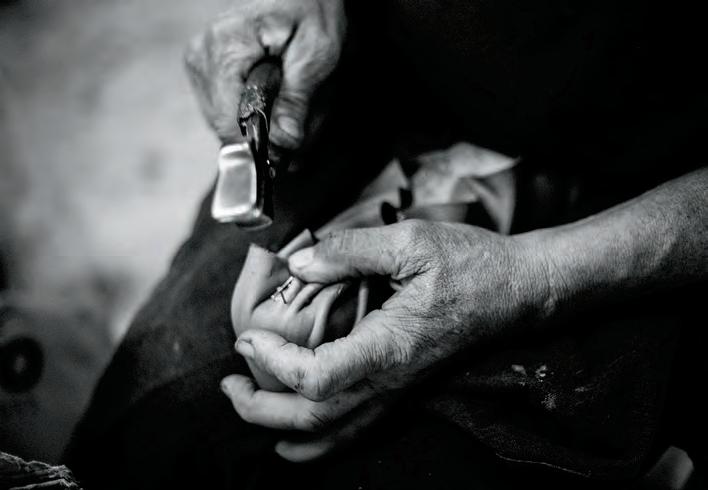
At Paolo Scafora, it can take as many as 30 days to make a pair of shoes—and so be it.
Paolo Scafora’s bespoke service takes personalization of shoes to the next level—to the ultimate in shoe fitting. The process begins with a fitting session at which the customer’s feet are measured in person before style, materials, colors and sole construction are selected, guided throughout by an expert. From here, a “fitting pair” of shoes is made for the customer to try on at a second fitting session. Any necessary modifications are then made before the customer receives the “test pair” of shoes.
With feedback from the test pair, Paolo Scafora proceeds at last with the final shoes, which are handcut, hand-stitched and hand-painted and polished. To complete the process, company founder Paolo presents the shoes to the customer in person—usually in Naples, Milan or New York—to ensure the shoes match the highest of expectations.
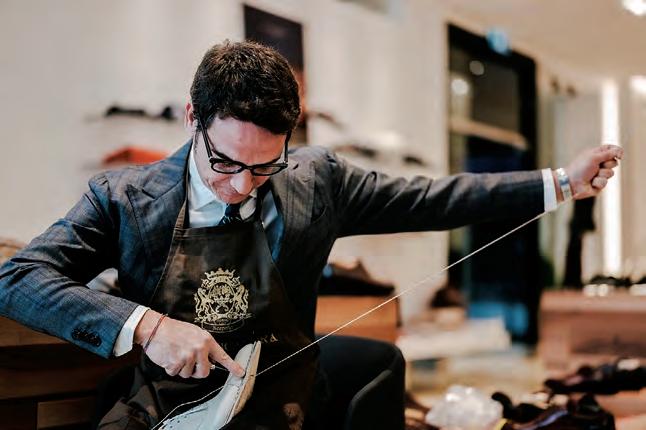
Such purity and attention to detail explain why a pair of Paolo Scafora shoes might take 30 days for the shoemaking process alone. Some things, however, are worth the wait. —robin

 barwick
barwick
Paolo presents the shoes to the customer in person.


















Hitting
Stay: The California dream is alive and well at the Ritz-Carlton Bacara, Santa Barbara, where whitewashed, red-tileroofed villas line a coastal cliff above a sandy beach about 15 minutes north of the city. With its multiple pools, restaurants, walking trails and outdoor adventures, Bacara is the kind of place that caters equally to couples, families with small kids, wedding parties and just about everyone else. But it’s especially wellsuited to golfers, given its location right next door to…
Play: Sandpiper Golf Club is, like its immediate neighbor to the north, a California classic. With a Pebble Beach–esque clifftop setting, the Billy Bell Jr. design is high on drama, with several stunning oceanfront holes. Of course, this is laid-back Santa Barbara, so expect to see locals playing this first-class track in boardshorts and bare feet. You might also spot coyotes strolling the fairways, hawks and pelicans soaring overhead, and dolphins and humpback whales breaching offshore. If rivers and rolling hills are more your thing, head out to one of the region’s top inland layouts, the River Course

at Alisal in Solvang or the notoriously challenging La Purisima—nicknamed La Piranha—in Lompoc. And if you can find your way onto the Jack Nicklaus Signature Course at the private Montecito Club, don’t hesitate to do so.
Sip: After a round at Sandpiper, retire to the new Bacara Wine Tasting Room next door. Opened at the resort in October, the cozy, library-like space offers an educational journey through the region’s astonishing breadth of varietals and styles. Pinot Noir from Babcock, Chardonnay from Brewer-Clifton, Cabernet Sauvignon from Crown Point—the curated selection of bottles, by-the-glass options and tasting flights will have you planning your next trip to Santa Barbara.

the links on the California Riviera is a low-key—but highdrama—affair.Sandpiper Golf Club and the Bacara Wine Tasting Room at the Ritz-Carlton.
scene in Santa Barbara proper. Start by sampling the masterful blends of Sanguis (appointment only), one of the few operations that produces, ages and bottles its wines in the city. Next, take a stroll through the nearby Funk Zone, an old warehouse district that is now home to lively restaurants and tasting rooms including Santa Barbara Wine Collective and Margerum Wine Company. For the full wine-country experience, however, you need a day—preferably two—out in the valley. Head straight to BrewerClifton in Los Olivos, where you can savor Pinot Noirs and Chardonnays from Wine Enthusiast Winemaker of the Year Greg Brewer. Stop into Liquid Farm and Dragonette before venturing to nearby Los Alamos for a vineyard tour and tasting at Casa Dumetz.
Stay: Staying at El Encanto, a Belmond Hotel, must be what it feels like to live in Santa Barbara—only better. Set in a residential area above the city’s historic mission, the restored 1920s-era retreat is an idealized version of a coastal neighborhood, with quaint cottages framed by rose bushes, wisteria vines, lily ponds and palm trees. Though serene to an extreme, El Encanto is close to the action, with a central location that’s ideal for exploring the city, nearby beaches and the vineyards of the Santa Ynez Valley.

Sip: El Encanto offers wine-tasting trips in the valley with the local tour company Coastal Concierge. First, however, kick off your weekend with an afternoon exploring the fun and fascinating wine
Eat: Like the wine, the cuisine of Santa Barbara County has reached new heights in recent years. Bell’s—located across the street from Casa Dumetz in Los Alamos— is a shining example of that rise, having earned a Michelin star since being opened by husband-and-wife team Greg and Daisy Ryan in 2018. Also in Los Alamos, the bakery and café Bob’s Well Bread has a cult-like following (some of whom have been known to make the three-hour drive from L.A. just for the bread). In Los Olivos, the Ryans’ two-year-old Bar Le Côte serves up exceptional seafood dishes in a casual setting next door to BrewerClifton. Back in Santa Barbara, find great local dishes and wines at Barbareño and Bouchon. But be sure to set aside at least one night for dinner on El Encanto’s terrace, where new executive chef Conny Andersson’s plant-focused menu comes with bird’s-eye views of Santa Barbara and the Pacific. —bruce wallin


In the two decades since Sideways, Santa Barbara County has evolved into a world-class culinary destination.Bonjwing Lee





When it debuted 25 years ago this summer, the inaugural course at Whistling Straits recast the concept of resort golf.


When the late Herb Kohler and Pete Dye surveyed the land along the shores of Lake Michigan that would eventually become The Straits course, the duo took inspiration from their multiple golfing trips together to Ireland and Scotland. Kohler provided a single directive— to create a course that rivaled Ballybunion—then stepped aside and watched Dye transform the otherwise flat parcel of land, bringing in more than 10,000 truckloads of sand along the way. “I wouldn’t interfere with him, I just let him go,” Kohler once said of the process. “His execution was really unbelievable.”

Dye spent three years on the design and construction, with the course finally opening on July 6, 1998. In the quarter century since, The Straits has hosted three PGA Championships, a U.S. Senior Open and, most recently, the Ryder Cup, and it has unquestionably become a bucket-list golfing destination. It has also helped change the way both pros and amateurs play in Wisconsin and beyond.
Michael O’Reilly, the PGA director of golf operations at Destination Kohler, says the 7,790-yard layout presented a new look—and new challenges—when it hosted the 2004 PGA Championship, a tournament that was traditionally held at private clubs of the Riviera, Winged Foot, and Medinah variety. “Being a links-style golf course with windswept bunkers, it was a different style,” O’Reilly notes.
The Straits also rebuked the notion that resort courses were excessively forgiving and largely uninspiring. Although there were a few exceptions, the vast majority of resort layouts at that time lacked the drama and dynamic shot-making that were inherent in a round played on The Straits. “It opened up really good golf, really good design, and really good golf experiences to the public,” O’Reilly says. “It was a trailblazer in the state of Wisconsin, which had a ripple effect across the entire country.” —shaun tolson

“His execution was really unbelievable.”
—Herb Kohler




As a comprehensive renovation nears its completion at the Homestead Resort, the property’s flagship golf course turns 100.
Since it opened for play a century ago, the Cascades Course at the Omni Homestead Resort has been reason enough for golfers to make the pilgrimage to western Virginia. Thanks to Omni’s ongoing restoration and renovation efforts—a project that commenced in the fall of 2021 and has since surpassed $150 million—the list of reasons to visit this historic resort keeps growing.
With emphasis placed on sophisticated motifs and a residential ambience, the Homestead’s executive team is overseeing the final phases of a project that has spanned all 483 guest rooms, 28 meeting spaces, a 100-year-old theater and more. “The attention to detail, from the sculpted carpeting in the Great Hall to the thoughtfully coordinated color and decor themes for each guest wing, is quite remarkable,” says Mark Spadoni, Homestead’s managing director. “We are especially pleased to be doing so in a manner that preserves our resort’s history.”
That history includes visits made by almost two dozen U.S. presidents, including Thomas Jefferson, who stayed at the resort for three weeks in 1818, frequently soaking in the mineral-rich Warm Springs Pools. The bathhouses that surround those pools were also recently renovated, allowing the resort to reopen the historic soaking areas after more than five years of closure. “It’s been incredibly gratifying to see these phenomenal structures restored to their former glory,” Spadoni says.
As for the Cascades Course, which this year celebrates its centennial, the 6,908-yard William Flynn layout is home to a dogleg par-4 (the 10th) that Arnold Palmer deemed one of his 54 favorite holes in America. There are many other compelling holes throughout, which helps explain why Sam Snead called the Cascades home for the entirety of his career, also serving as the Homestead’s first resident golf professional. “If you can play the Cascades,” Snead said, “you can play anywhere.” —shaun tolson

Major champ Justin Leonard is warming to his new brief on the PGA Tour Champions.
You turned 50 last year, joined the PGA Tour Champions, and your form is trending in the right direction. Is a win on the horizon?
I am definitely going in the right direction. It is probably happening a little slower than I would prefer, but sometimes things don’t always happen in the exact timeframe that we want!
Strong recent results suggest you are enjoying being back in the old routine. It feels like being back on the PGA Tour, but just 25 years ago! A lot of these guys I’ve known for so long, and that is one of the reasons it is so fun. The atmosphere is great, and it has been a lot of fun for me to get back into competition again.
And the next generation is coming up fast. Didn’t your son Luke recently play in a competition with Tiger Woods’ son Charlie?
Yes, that was a lot of fun. They got paired together in a junior club championship. They go to the same school, too, but this
was Luke’s first time playing golf with Charlie, and I know it was his first time to play in front of Tiger Woods.
It was cool, and it was fun to watch, and then talking about junior golf with Tiger for nine holes, and talking about the little things we see in our kids that they need to work on, or whatever it may be.
There was a shot that Charlie hit into 12, which was a par-5; this beautiful high, soft cut—looked like a 3-hybrid or something. The ball landed on the green, and it stopped dead. There might have been a little bit of a club twirl at the end of the shot, and I walked by Tiger and said, “Okay, a lot of that looked very familiar,” and we both had a good chuckle.
You grew up playing golf at Royal Oaks CC in Dallas. When did you start there? I started my golf there so that must have been in the late seventies. My first golf lessons were with Randy Smith, when he was the assistant. It is amazing that Randy is still at the club, and these days he has some long, fancy title.
Randy Smith is the golf professional emeritus & director of instruction (working with Scottie Scheffler among other tour pros). What makes Randy such a good coach?
His way of communicating ideas and thoughts is great. He can relate and communicate to a 10-year-old junior just as well as he relates to a 70-year-old, and everyone in between. He also has a great eye, and he can pick up things in a golf swing that most people can’t and that is a real talent—and it is one that I don’t possess, I can tell you that.
I also love that there does not seem to be a set method to his teaching. He just works with what a player has and tries to help them improve.
You won The Open at Royal Troon in 1997. Did you take the Claret Jug back to Royal Oaks?
Yes, straight away! I got back to Dallas on the Monday morning, and my parents picked me up from the airport. I couldn’t wait to get home and take a shower. It had been a long flight, and I hadn’t slept much. They said, “No, we need to go to Royal Oaks.” I said, “No, that can wait, I need to go home.” Well, my dad was driving, and we went to Royal Oaks despite what I said, and there were 400, 500 people there in the ball room. I didn’t know a thing about it—it was great—so everyone got to see the Claret Jug that day. I had noticed lots of cars in the parking lot but hadn’t thought anything of it. —robin barwick






THE WORLD’S FIRST ELECTRIC GOLF CADDIE WITH ACTIVE TERRAIN CONTROL










With every Ryder Cup player appearance representing one credit (so 12 European credits for every Ryder Cup), here is a ranking of how many credits each participating country has accumulated since the team became “Europe” in 1979:
42 Spain 35 Scotland 19 Sweden



The British and Irish Ryder Cup team expanded to include all of Europe in 1979, and this year Italy will be the seventh different European country to host the famous matches.

Only two European countries have been represented in all 21 Ryder Cups since 1979: England and Spain.
and Spain.

European countries that have hosted the Ryder Cup since it began in 1927:
2023


Sweden has 19 “credits”—behind only England, Spain and Scotland—yet has never hosted the Ryder Cup.
Swedes in the Ryder Cup:

1. Joakim Haeggman (1993)
2. Per-Ulrik Johansson (1995, ’97)
3. Jesper Parnevik (1997, ’99, ’02)
4. Jarmo Sandelin (1999)

5. Niclas Fasth (2002)



6. Pierre Fulke (2002)

7. Robert Karlsson (2006, ’08)
8. Henrik Stenson (2006, ’08, ’14, ’16, ’18)
9. Peter Hanson (2010, ’12)
10. Alex Noren (2018)
A player in five Ryder Cups, the most by any Swede, Henrik Stenson was a popular appointment as captain of the 2023 European team—until he lost the job when he joined the LIV Tour.
Sweden has twice hosted the women’s Solheim Cup, in 2003 and 2007. It was on the short list to host the 2018 Ryder Cup, but the Swedish Golf Federation withdrew its bid due to a shortfall of sponsor backing.

e King of Sweden’s motto is: “För Sverige i tiden!”
It is a call to move with the times and not to get stuck in the past, and Sweden beckons for a future Ryder Cup.

























As a longtime sponsor of the Turkish Airlines World Golf Cup and many other golfing events, Turkish Airlines suppo s the deep-rooted passion behind the spo . Making it more convenient for golf-lovers to take their passion to new destinations, the airline offers passengers the oppo unity to carry their first set of golf clubs and golf equipment, such as golf shoes and a golf bag, free of charge on all Turkish Airlines flights.
Flying to more countries than any other airline in the world, Turkish Airlines invites passengers to visit their favorite destinations and discover new horizons with comfo and ease. From its 12 United States gateways, the airline seamlessly connects passengers through its centrally located hub in Istanbul to more than 340 destinations in 129 countries across five continents.




























In addition to having one of the most robust flight networks, Turkish Airlines offers an award-winning Business Class service. Business class passengers enjoy modern full flat seats with a first-rate ente ainment system, free WIFI service on all wide body fleet, active noise-canceling headphones by Denon, a Ferragamo special amenity kit, a welcome drink and dedicated bar, turnup service and sleeping kit on long haul flights, a snack bar, Turkish coffee and Turkish delight service, a special menu with gourmet meals, hot towel service, dedicated lavatory with live plants, and more.

As of 2023, Turkish Airlines now offers passengers transiting through Terminal 1 of New York’s John F. Kennedy International Airpo (JFK) an elevated lounge true to the Turkish Airlines experience. The lounge amenities are synonymous with the brand’s comfo and hospitality in the newly renovated and rebranded space. Featuring the famous flavors of Turkish cuisine, passengers can enjoy three meals a day including breakfast, lunch and dinner served uninterruptedly, in a though ully designed mid-century inspired space created for function and comfo .


Turkish Airlines offers passengers award-winning cuisine featuring premium menus prepared with fresh ingredients, cou esy of Turkish DO & CO. With a strong commitment for its quality of service and maintaining its status of the airline with the world’s best inflight dining concept, Turkish Airlines launched new inflight menus this year for domestic and international flights. The new menus draw inspiration from healthy nutrition trends and include eclectic flavors from traditional Turkish cuisine and global cuisines, with 80% of ingredients sourced from local producers. Flying Chefs, a unique in-flight chef service offered on all long-distance flights and some sho distance flights, offers passengers the luxury experience of dining at a restaurant high above the clouds.














Turkish Airlines offers its passengers the oppo unity to discover the world’s connection center, Istanbul, and its unique wonders with its stopover accommodation service for passengers with lengthy transfer times. As pa of its Stopover Service, Turkish Airlines provides a two-night stay in a 4-star hotel for economy class travelers and a three-night stay in a 5-star hotel for business class passengers.
For travelers looking to extend their stay, Türkiye offers 24 golf courses, 15 of which are nestled together in Antalya in the region of Belek, close to the Mediterranean Sea, and known as the Turkish Riviera. Antalya, notably the Belek reso area, offers luxury hotels and reso s with international standards of luxury, superb accommodations, a gourmet dining and pampering service and features numerous championship courses.
Türkiye is a modern country with a captivating blend of antiquity and contemporary and of East and West. The cradle of civilization and center of world history today stands as one of the fastest-growing tourism destinations in the world. Its spectacular coastline, majestic mountains, cosmopolitan cities, and quaint villages make it one of the world’s most fascinating destinations.

2 nights for Economy Class 3 nights for Business Class
You can extend your stay with special prices sta ing from 49 USD per night

Arnold Palmer was a true patriot, but he knew that patriotism was best demonstrated through honor and friendship.



While Billy Casper won more points overall (23½), Arnold Palmer still holds the American Ryder Cup record for 22 outright wins.
“I loved the Ryder Cup, because it simply wasn’t about playing for money,” Arnold Palmer wrote in A Golfer’s Life. “It was about playing for something far grander and more personal than income and money lists. It was all about playing for your country, your people, and therefore yourself, and it was a pure joy to try to beat the best of Britain and Ireland in an honorable game almost as old as the Magna Carta.”
Palmer made his Ryder Cup debut at Royal Lytham and St. Anne’s in 1961. Years after his playing days in the Ryder Cup were complete, he admitted that singing the national anthem at the opening ceremony for the first time brought tears to his eyes and, he recalled: “As we marched out I noticed my legs were shaking”.

Palmer played for the United States in the Ryder Cup six times, winning 22 outright matches over the six appearances, with two halved points completing a career points tally of 23. The 22 wins set a Ryder Cup record until Englishman Sir Nick Faldo surpassed it in the 1997 Ryder Cup at Valderrama, Spain.
Career record: 31 matches
22 Wins 7 Losses 2 Halves
Years played: 1961, 1963, 1965, 1967, 1971, 1973
Years captain: 1963 (playing captain), 1975
Singles: Won 6 Lost 3 Halved 2
Foursomes: Won 9 Lost 3 Halved 0
Fourballs: Won 7 Lost 1 Halved 0
The United States won on all seven occasions that Palmer played and captained, yet he never lost sight of the importance of golf remaining an “honorable game.” To Palmer, friendships would not be forsaken for competition, but rather the opposite; that the heat of sporting competition forged some of his most enduring friendships. One of Palmer’s early Ryder Cup rivals was England’s Peter Alliss. Palmer wrote of the man who became a close friend:
“Peter was an elegant man and an accomplished player. I greatly admired the way Peter played the game, with such precision and accuracy… and it says something nice about the man’s quiet tenacity that I had to work my tail off simply to halve the match with him [in singles in 1961]. Cordially shaking hands, I think both of us knew we’d been in a dogfight.”
In an interview with Kingdom in 2012, Palmer said: “To this day, I firmly believe the spirit of fair play and sportsmanship that prompted Samuel Ryder to create this transatlantic challenge in the first place remains as valid as it was back in the 1920s. Certainly, the six Ryder Cups in which I played were equally enjoyable for the quality of the golf and the courtesy and consideration displayed by all the players both off the course and in the heat of battle.
“Long may this attitude continue, not least because the Ryder Cup is perhaps the greatest showcase that we have in the game.”
“The Ryder Cup is perhaps the greatest showcase that we have in the game.”
The records show that Steven Alker won the 2023 Insperity Invitational, yet there were many more winners at this prestigious event on the PGA Tour Champions.



In keeping with long-standing tradition, Junior Day dominated Tuesday’s order of play at the 20th Insperity Invitational, held in April at The Woodlands Country Club outside of Houston. It’s not an occasion that grabs the headlines, but Junior Day—at which 36 aspiring young golfers are rewarded with a 9-hole Junior Pro-Am, playing alongside the stars of the PGA Tour Champions—is a highlight for both the participants and the organizers of the annual event.
“We provide an opportunity of a lifetime for 18 boys and 18 girls who qualify for the Junior Pro-Am through the Southern Texas PGA Section,” says Jane Wandmacher, tournament director of the Insperity Invitational. “These aspiring young golfers are awarded the pro-am experience inside the ropes, on the Tournament Course. They get to bring a caddie, their parents come out to watch, and we host them all for lunch and a clinic. It is a great opportunity for golf’s future in southern Texas to play alongside the pros.”

Guiding these young hopefuls around the course this year were PGA Tour Champions stars Steven Alker—the eventual winner of the Insperity Invitational—Robert Karlsson, Kirk Triplett, José María Olazábal, Joe Durant, Tom Pernice, Miguel Ángel Jiménez, Ken Tanigawa and Steve Flesch.
“I have played the Junior Pro-Am for the last few years,” Pernice tells Kingdom. “These kids have qualified for the pro-am, and it is pretty special for them to play golf inside the ropes.”
Pernice, 63, is a six-time winner on the PGA Tour Champions, and twice lifted trophies on the PGA Tour. “I like to see how the juniors are doing, what level they are at, and see how I can help them and give them some insight into their progression through junior golf, high school and then hopefully onto college,” he says.
Junior Day was also highlighted by the SUCCESS Golf program (Students Undertaking Challenging Courses Ensuring Development of Sportsmanship and Skill)—part of the Be An Angel Foundation—which set up an adaptive 9-hole miniature golf course on the driving range for local children with disabilities and special needs. “The miniature golf course was enjoyed by around 50 kids from different schools in the Houston area,” says Wandmacher. “Players spent time there and putted with the kids, and so did some of the Junior Pro-Am golfers. It is a great opportunity for the children with special needs to experience golf and the tournament. They also have lunch, they receive t-shirts and medals—it’s a fun day.”
Adds Pernice: “Any time you get an opportunity to make a difference and help someone to enjoy their day a little bit more, it is a pretty simple thing to do. As tour golfers, we are grateful for what we have in our lives, so it is important to give something back.”
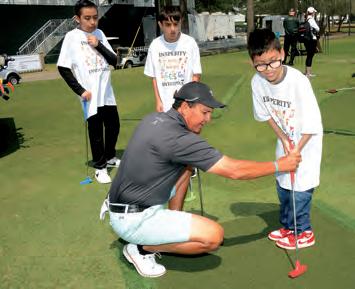
“It is a great opportunity for golf’s future in southern Texas to play alongside the pros.”
Golf in the morning. Wine tasting in the afternoon. That’s a tradition we could get used to. Fortunately, the options for vacation homes that pair the pleasures of the course and vine are plentiful everywhere from Northern California to Southern Africa. Here, we raise a glass to a few of our favorites.

 By Shivani Vora
The Ridge Course at Predator Ridge
By Shivani Vora
The Ridge Course at Predator Ridge

Location: About a four-hour drive east of Vancouver, the Okanagan Valley is a stunning region replete with lakes, valleys, orchards and vineyards, the latter of which are the source of excellent ice wines. While these sweet and crisp expressions are what put the Okanagan on the global oenophile map, the region’s Chardonnays, Merlots and Pinot Noirs are also garnering acclaim.
Community: Spread over 1,400 acres, Predator Ridge is an exclusive community with a bevy of non-golf diversions, including tennis, biking, hiking, pickleball and swimming. Come winter, cross-country skiing and ice-skating reign.
Courses: Predator Ridge’s courses offer two distinct looks at the Okanagan. The Ridge is a challenging track that stands out for its rock outcroppings and panoramas of Lake Okanagan. The Predator is gentler by design, playing through rolling, fescue-covered hills. Together, they make up what is unquestionably one of Canada’s top golf resorts.
Residence: Set on a secluded cul-de-sac, this threebedroom contemporary mountain-chic home ($3.35 million) features oversized windows and high ceilings to allow for plenty of natural light and epic mountain views. A large saltwater swimming pool, rock waterfall and hot tub are a few of the standout amenities.
866.578.2233 . predatorridge.com
Location: Napa Valley gets the spotlight, but neighboring Sonoma is more than four times its size and has a varied landscape of rivers, coastlines, peaks, forests and farmland—a tableau of terroir that suits everything from Pinot and Chardonnay to Cabernet and Sauvignon Blanc.
Community: Mayacama is an elegant private resort outside the vibrant town of Healdsburg. Homeowners never lack for fun, with 675 acres at their disposal that include tennis and pickleball courts, a swim center, restaurants, jogging trails and a spa. There’s also a calendar packed with concerts, themed dinners and more.
Course: A Jack Nicklaus classic, Mayacama’s course traverses valleys and hills, offering dramatic views of Sonoma wine country from elevated tee boxes. Wear comfortable shoes, as there are no golf carts allowed.
Residences: Mayacama’s Tuscan-style turnkey villas ($4.8 million) are a generously sized 4,200 square feet and have four bedrooms and baths. Each offers course views, as well as three outdoor firepits and covered patios.

707.387.0449

Location: Dramatic mountains, piercing green vineyards, design-centric wine estates—all just a short drive from the dynamic city of Cape Town—South Africa’s Cape Winelands are a sight to behold. The views are even better with a glass of local Chenin Blanc, Colombard, Shiraz or Petit Verdot in hand.
Community: Val de Vie Estate is in the heart of the area’s Paarl-Franschhoek Valley region. The community spans close to 2,500 acres and has a long lineup of amenities, including multiple gyms and swimming pools, polo fields, a soccer field, an equestrian center and tennis courts.

Course: Val de Vie’s Pearl Valley Jack Nicklaus Signature Golf Course ranks high among Africa’s best designs, highlighted by the par-4 7th and 8th holes that circle the largest of the community’s five lakes.

Residence: Built directly on the course with views of the 7th and 8th fairways, this contemporary estate ($1.25 million) blends interior spaces with the Cape Winelands’ glorious outdoors. Large windows and glass doors lead to the swimming pool, garden, braai (barbecue) area and covered patios. Indoor features include five bedrooms and, appropriately, a wine cellar.
+27.21.863.6105 . valdevie.co.za

Location: Cobblestoned medieval villages, rolling terrain and verdant river valleys are all part of the Provence experience. The region also has a flourishing wine scene that dates back at least 2,500 years and is best known for its rosés.
Community: Terre Blanche is a more than 700-acre development that has a charming small-town feel, with private residences, a hotel, a spa and miles of walking paths through forests and gardens. The resort has a special focus on wellness, with its souped-up gyms, healthy cuisine and abundance of programs to improve fitness, sleep and energy.
Courses: One of Continental Europe’s best one-two combos, Terre Blanche’s Le Riou and Le Château courses both offer stiff challenges and sweeping views of the surrounding countryside and villages. Le Château is open to resort guests, while Le Riou is reserved for members. Residence: The beauty of Provence is in appreciating the outdoors, and this quintessential Provencal home ($5.5 million) offers numerous terraces, a swimming pool, a hot tub and a pétanque court to do just that. Situated at the end of a long path and surrounded by towering trees, this resort within a resort also has a sauna, gym, wine cellar and massive primary suite.
+33.(0)494.399.000 . terre-blanche.com









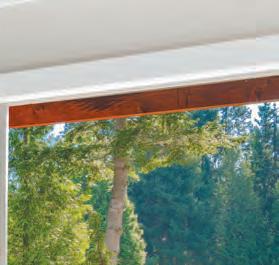













 SilverRock Resort
SilverRock Resort
SilverRock Resort
SilverRock Resort
“You don’t need to tell anybody how good you are. You show them how good you are.”
“You don’t need to tell anybody how good you are. You show them how good you are.”
— ARNOLD PALMER — ARNOLDPALMERarnoldpalmerdesign.com
arnoldpalmerdesign.com


 By Shaun Tolson
By Shaun Tolson
Moments after tapping in a par putt on the 18th hole to win the 2023 Insperity Invitational at The Woodlands Country Club in Texas this past April, Steven Alker pointed to a throng of supporters in the gallery just behind the green, all clad in bright orange Houston Astros garb. Alker tapped his heart three times and pointed to the sky before returning his glance to the 50 or so people in his cheering section to give them a thumbs-up.
The victory marked the New Zealander’s successful title defense at the Champions Tour event, which this year celebrated its 20th anniversary. And while his fourstroke win was as emotional as it was momentous, those emotions—felt by Alker and his bevy of baseballjersey-clad fans—were a mixture of jubilation and heartache. In early February, Alker’s caddie of four years, Sam Workman, died of cancer only a short time after his diagnosis was reported.
The 56-year-old Workman had spent his entire professional life in golf, first as a teaching pro, then operating a municipal course and finally working as a caddie on the Korn Ferry and Champions tours. The native Texan lived not far from Houston and was a passionate Astros fan, which is why this spring almost 50 of his friends and family members donned personalized Astros jerseys with the Workman name embroidered on
the back—and followed Alker around the 7,000-yard layout, cheering the Kiwi on at every swing.
Taking Workman’s place that weekend was Alker’s 18-year-old son, Ben, who slipped on a caddie bib for the first time. “We were pretty relaxed and talking and interacting about other things, and I was keeping an eye on him and making sure he was okay,” Alker says, recalling the tournament’s final round. In fact, the 51-year-old pro believes that the attention he paid to how his son performed on the bag was a positive distraction. “It took my focus off the thought of winning or the past shots that I’d hit,” he adds. “It was one of the toughest nine holes I’ve played in a long time. It was emotional in terms of the thoughts and feelings, and it was really hard work to keep myself mentally in a place to give myself a chance to win.”
If any player in the field could handle those challenges, it was Alker, who turned professional at 24 years of age in 1995, then spent more than two decades grinding on several tours, qualifying for the occasional PGA Tour event here and there but, for the most part, stuck in a perpetual chase of his dream to play golf at the highest professional level. Across 20 seasons on the Korn Ferry Tour—some years playing a full slate of events, others just a single tournament—Alker missed almost as many cuts as he made. Early on in his career, the journeyman
After decades of limited success on golf’s various professional circuits, the journeyman from New Zealand is putting it all together on the Champions Tour.Steven Alker on his march to victory at the 2023 Insperity Invitational outside of Houston
The resort experience you never saw coming.
Celebrating the legacy of Grand Cypress, our Jack Nicklaus Signature Golf offers the world championship quality courses you’ve come to expect amid Orlando’s newest and most highly anticipated resort.

Evermore Orlando Resort Opening Late 2023


Learn more about Grand Cypress Golf at evermoreresort.golf


also competed on the PGA Tour of Australasia, the Australasian Development Tour, the Canadian Tour and the European Tour.
“I think the grinding aspect on all those small tours… it prepared me for anything,” he says. “I’m comfortable feeling uncomfortable.”
That preparation was on display during the second round of the tournament, when a cold front moved through the region, bringing cooler temperatures and gusty conditions. Of the 76 players who completed their rounds that Saturday, only 10 shot under par. Of those 10, Alker was the only player to post a score in the 60s.

Weeks following the event, Alker reflected on the accomplishment and attributed his success to the years he played on those mini-tours around the world, especially throughout Europe, where he was often teeing it up each week in a different country with distinct weather. “I learned from a young age to have a lot of shots in my arsenal,” he says. “I like to use a lot of imagination when practicing now so that I’m not getting too one-dimensional. If you get low round of the day, it’s a good sign that your game’s on and you can still play in those conditions.”
As one might expect, a career largely spent grinding out a living on developmental tours produced more than one occasion where Alker and his wife had to reevaluate
their plans for the future. From 2009 to 2012, Alker only made 16 cuts in 75 Korn Ferry tournament appearances. The couple talked more than once about selling some of their belongings or supplementing Alker’s play on tour with a steadier stream of income, but through it all they remained resolute in his journey. “My wife and I could’ve decided a long time ago that enough was enough,” he says. “But I never got to that point.”
At that stage in his career, what Alker lacked in distance or ball-striking ability he made up for with a stellar short game and sound course management. There was a time when he even considered opening a golf academy that would teach aspiring players the fundamentals in those two areas. When asked about that aspiration following his victory at The Woodlands earlier this year, Alker acknowledged it was a business idea born out of necessity. In other words, it was an option that he would have considered if his struggles on tour continued. “Now, I don’t know if I want to teach that much,” he said, flashing a smile.
Ninety minutes earlier, his play out on the course flashed the brilliance of that short game, where deft pitches and chips down the stretch helped the defending champion shoot two-under through the final four holes. The resulting victory was Alker’s sixth on the Champions Tour—proof that he’s finally found his groove playing
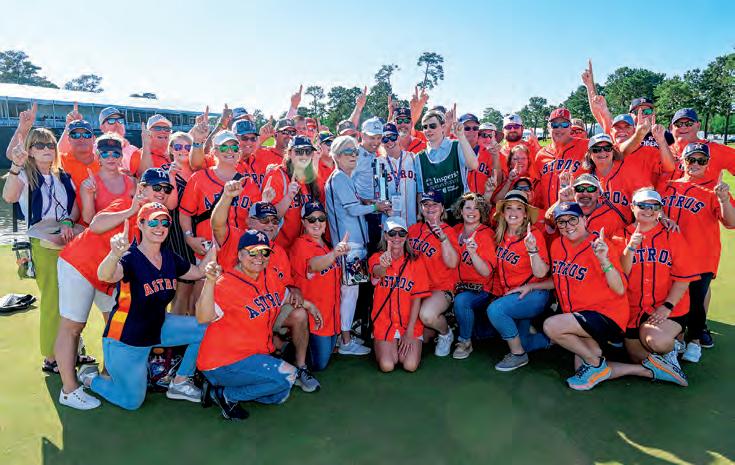
amongst the world’s best. When juxtaposed by his unwavering commitment to keep chasing his dream, his recent success is all the more remarkable.
Thanks to the Covid pandemic—a statement that’s not often made—Alker was able to keep his playing status on the Korn Ferry Tour until he was 50, leading right up to his eligibility for the Champions Tour. “Looking forward to the change of atmosphere, of being amongst the Champions guys and competing in a different atmosphere, it invigorated me and made me want to stay in the game and work hard,” he explains. “I knew there was a tough road ahead. I still had to get on tour, which is hard out on Champions. But it was a second chance for me, and second chances don’t come along very often.”
When the first opportunity to seize that second chance came along, Alker didn’t miss. He played his way into the Boeing Classic in August 2021 as a Monday qualifier, then finished in a tie for seventh. A top-10 finish secured him an automatic spot in the next Champions Tour event, where he finished third. That pattern continued through the middle of October. When all was said and done, the New Zealander had posted six consecutive top-10 finishes in eight weeks. At the conclusion of his ninth Champions Tour event, the TimberTech Championship—which he won—Alker had earned more money in 12 weeks on the Champions Tour than he had across 13 years (and 86 career starts) on the PGA Tour.

Last year, Alker kept that momentum going, playing in 23 events, winning four of them, finishing runner
up four additional times and placing inside the top 10 another 14 instances. In the end, he was awarded the Charles Schwab Cup as the tour’s leading money winner, having earned more than $3.5 million.
Alker has cherished his Champions Tour experience in a way that goes far beyond the success that he’s had and the money that he’s won. “It’s been amazing to get to know these guys, including some that I played with on the PGA Tour but never got to know,” he says. “The PGA Tour has a different feel, and it’s just a different vibe on the PGA Champions, and I like it. To have those relationships with the guys and to have a bit of a laugh with these guys as we’re still competing, that’s been a lot of fun the last couple of years.
“I think the guys on the Champions Tour have loosened up a little bit and softened a little in their old age,” he continues. “They’re more approachable and enjoying this part of their life a bit more. I certainly am.”
That enjoyment extends through the Alker family, as well. After years of chasing a dream, all the while burdened by the stress of trying to make ends meet, Alker and his wife are now relishing this current chapter in their lives. “Our appreciation has gone through the roof,” he says. “To be where we’re at, the money we’re playing for and to be doing this at 51…what more can you ask?”
“I knew there was a tough road ahead... But it was a second chance for me.”With the Charles Schwab Cup, awarded to the Champions Tour’s leading money winner.

Dormie Network offers far more than just a superior 18 holes: each club creates customized experiences perfect for entertaining—and impressing. Perfect for business or pleasure, your membership gets you full access to each destination.




Get on the list at dormienetwork.com/kingdom
Where every club is your home club.



n ancient Rome, chariot teams at the Circus Maximus would race in red, white, blue and green. Come September 2023, more than 2,000 years later, the colors have not changed much, as the red, white and blue of the United States arrives in the Eternal City to face the blue and gold of Europe in the 44th Ryder Cup. Marco Simone Golf & Country Club has an immaculate golf course built especially for the occasion of Italy’s first Ryder Cup. It is a layout fitting for many of the world’s finest golfers, including world No. 1 Scottie Scheffler, who is set to play in the Ryder Cup for the second time. The challenge for the American team is clear: win the Ryder Cup in Europe for the first time in 30 years.

Joel Edwards is among the many tour golfers who have spent days on end working on their game at Royal Oaks Country Club on the north side of Dallas. Royal Oaks is a friendly, family club with a good parkland golf course and excellent practice facilities, and one day about 15 years ago, Edwards was on the range, dialing in his wedges under the tutelage of head professional Randy Smith.
ere was a pole on the range, 80 yards away, and Edwards was using it as his target.
“Joel was hitting these wedge shots so good,” recalls Smith, who joined Royal Oaks as the assistant pro in 1976. He was soon promoted to head professional, never le the club and is now golf professional emeritus and director of instruction.

A skinny little kid, one of the juniors named Scottie, wandered up and asked what Edwards was working on. “I’m hitting this 80-yard shot,” said Edwards, who had a PGA Tour title under his belt, from 2001. “Pretty good, huh?”
e kid took out his wedge, rolled over a spare ball, took aim at the pole and bang! hit it square on the rst attempt.
Edwards turned around, and Scottie was grinning from ear to ear, “Like that?” he asked.
“Scottie took a few more shots at the pole and hit it twice more,” recalls Smith. “Out of six shots, he hit the pole three times. Joel went crazy. He was losing it. He said, ‘I’m not leaving here until I hit that pole!’
“I moved on to go and teach someone else, and then about an hour later I heard this ker-ching! Joel had nally hit the pole. Joel and Scottie were both jumping around high ving, with Scottie not two and a half feet tall.
“It became ridiculous with the things Scottie could do, and he would drive the tour golfers crazy.”
Scottie Scheffler has come a long way in a short space of time—the Texan has won six times in the past 18 months, after all—yet looking back to his childhood days at Royal Oaks CC in Dallas, something truly special always seemed likely. Scheffler spoke to Robin Barwick.



















The Sche er family moved from New Jersey to Dallas when Scottie was seven, and nding the right country club was a high priority.

“Royal Oaks was great for my whole family because it has a pool,” starts Sche er—who is the sole brother among three Sche er sisters—in an exclusive interview with Kingdom. “ ere is a driving range with golf balls and a golf course, and that is all I needed, and the club took care of me. With Randy being around the whole time, it was just such a fun place to hang out. We could play tennis and sometimes we would even play football on the driving range. Randy made it such a fun and welcoming place for us kids, which perhaps is not all that common for country clubs. It was a great place for an 8-year-old to spend 10 hours every day.”
Royal Oaks has nurtured a string of tour players since Smith arrived in the late 1970s, and Sche er—the Masters champion of 2022—is third in line of the club’s major champs. One of Smith’s rst pupils was another under-sized kid with a special touch around the greens,
Justin Leonard, who went on to win e Open at Royal Troon in 1997, and Gary Woodland came up at Royal Oaks before claiming the U.S. Open at Pebble Beach in 2019. Harrison Fraser, Anthony Kim, Colt Knost and Martin Laird all made their way onto the PGA Tour via Royal Oaks and Smith’s coaching.
“One of the coolest things about Royal Oaks,” says Sche er, “is that Randy would be teaching Justin or Gary or others, and I could just sit there and watch. I would do it for hours and hours—just sit there on one of those range buckets and watch Randy teach and watch the guys practice, and I learned a ton from those guys.”
One of Smith’s first pupils was another under-sized kid with a special touch around the greens, Justin Leonard.
“To have strong juniors, a club needs a lead horse,” says Smith, 71, a PGA of America Hall of Famer since 2005. “A lead horse is a young player who is really good and who all the younger kids want to watch and hang out with, and they want to see what he is doing. That really happened at Royal Oaks when Justin was a junior. The beauty of it was that those kids were taking in what Justin did. It wasn’t so much about what I was teaching them, but that they were seeing how a U.S. amateur champion worked on his golf. They would see his work ethic.”
On one occasion—once he was established on tour and a major champion—Leonard was comparing a new set of wedges to his existing set.
“I would go through two or three sets of wedges a year at that time,” says Leonard. “The old wedges weren’t really very worn out, the grooves were still pretty good, but on tour we always like to have really sharp grooves. Randy asked if he could have them, and then a couple days later I was back at the club and I saw Scottie with my old wedges, after Randy had cut down the shafts. I think
that happened for a couple years, where Scottie would end up with my discarded wedges.”
It wasn’t long before Scheffler assumed the role of lead horse himself, particularly once he had equaled the record set by Jordan Spieth of winning the individual Texas state title three years in a row, 2012 to 2014. Aged 17 in 2013, Scheffler added the U.S. Junior Amateur title to his honor roll.
“Whenever Scottie and I get to work at the club, there will be four kids, aged between 11 and 18, and they will run out there and call distances for him, they’ll get him water, and then Scottie will have putting contests with them,” adds Smith. “For me as a golf professional, it is one of the most rewarding things to see.”

“To have strong juniors, a club needs a lead horse”
—Randy Smith
Since turning professional in 2018, Scheffler’s rise was steady at first, but with a sharply steepening trajectory over the past two years. He is World No. 1 (at the time of writing in June), a major champion and a six-time winner on the PGA Tour since the start of 2022. He is not just the lead horse at Royal Oaks anymore, and it can be hard to compute that less than two years ago he was really the last man onto the U.S. Ryder Cup team.
“That’s true,” admits Scheffler, who had a lot of top-five finishes on tour by the fall of 2021, and had shown real match-play guile in the spring by finishing runner-up to Billy Horschel in the 2021 WGC Match Play at Austin Country Club.
“I was the lowest-ranked player on the team, and I was the only player who had not won on the PGA Tour yet, so I really was the last man in,” he says. “We had such a talented team, and I was just fortunate to be part of it. I knew I had the backing of a few of the guys in the room when it came to rounding out who was going to play on the team. Some of the guys helped make that decision, and it means a lot when you get support like that.”
Scheffler partnered Bryson DeChambeau in both series of fourball matches, halving the first point and winning the next, before he teed up third in the decisive singles matches and dispatched European alpha Jon Rahm 4-and-3. There is no ignoring a result like that.


“I was in a good spot with my game,” recalls Scheffler. “I was moving up the world ranking, continuously improving, and then I had a great Sunday, and I was able to beat Jon in that environment, which definitely gave me some confidence moving forward.”
On that note, Scheffler went home after the Ryder Cup and promptly broke his own course record at Royal Oaks, shooting two halves of 29 for a 58 off the back tees.
In February 2022, Scheffler claimed his first PGA Tour victory at the Waste Management Phoenix Open, defeating Patrick Cantlay in a playoff, and then this lead
Scheffler won two-and-a-half points from three matches at the 2021 Ryder Cup and defeated Jon Rahm [top] in singles. Scheffler still works with Smith [middle] at Royal Oaks CC, where he joined at the age of seven.

horse really bolted. Scheffler won the Arnold Palmer Invitational at Bay Hill 21 days later, took the WGC Match Play for his third win in five starts, shot up to World No. 1 for the first time, and then tried on a green jacket for size at Augusta National, defeating Rory McIlroy by three shots in the Masters. He collected four wins in a stretch of only six tournaments and became the first golfer since Arnold Palmer to record four wins in a season by the Masters. And pause for breath.


Now a six-time PGA Tour winner (writing after the 2023 U.S. Open, where Scheffler finished third), back to World No. 1 and basically the first name on the U.S. Ryder Cup team sheet for Rome, Scheffler is just doing what comes naturally, and that means keeping things simple.
“I like being No. 1 a lot more than being No. 2,” he says, “but it is not something that gets me up in the morning. I just love competing, I love playing golf, and that is what gets me motivated. I always go back to simplicity. I try my best in every tournament, in every round, no matter what position I am in. I don’t place long-term goals or expectations on myself. I just keep working hard and let the results be the results.”
Just like when he hit that pole from 80 yards, three times in six shots, Scheffler doesn’t need to think too much for things to work out.




























The Ryder Cup arrives in Italy for the first time in September. Robin Barwick visited host venue Marco Simone Golf & Country Club, where the spheres of Italian sport and fashion have combined to create a thing of complete bellissimo.




It was the final round of the 2022 Italian Open, and Rory McIlroy stood on the 16th tee at Marco Simone Golf & Country Club in Rome. The world No. 2 (at the time) was a shot behind Robert MacIntyre and Matthew Fitzpatrick.
It was an exciting finale at the future venue of the 2023 Ryder Cup, taking place just a week after qualifying for the European team had commenced. MacIntyre (Scotland), Fitzpatrick (England) and McIlroy (Northern Ireland) were followed on the leader board by Victor Perez (France)—another Ryder Cup hopeful—in fourth place. Recently appointed team captain Luke Donald (England) had even been in contention after two rounds.
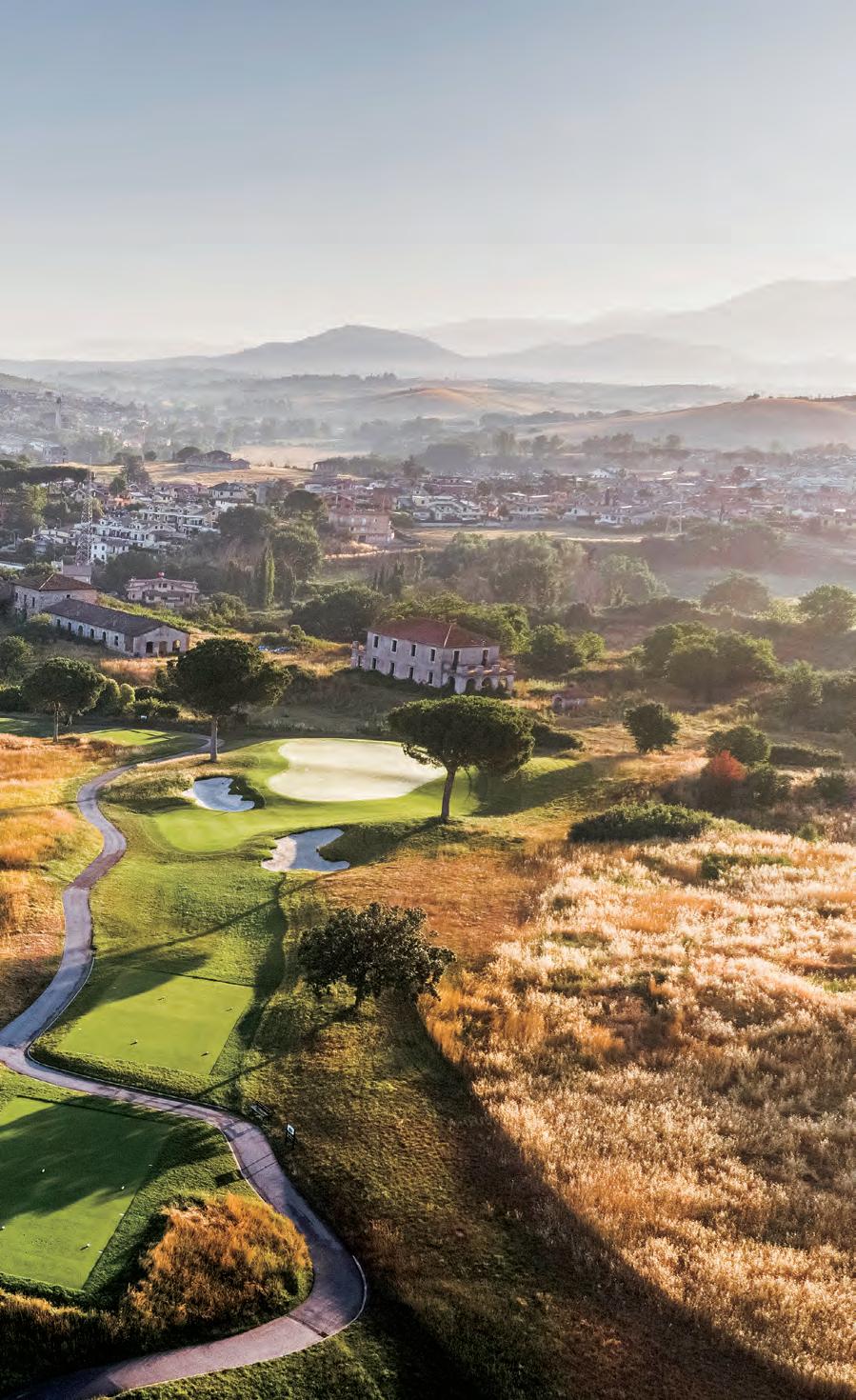
McIlroy wanted to stamp his authority on the Ryder Cup ranking and golf course in one fell swoop. Playing ahead, MacIntyre had birdied 16; McIlroy responded with a birdie at 15—his third in four holes—as a late charge gathered momentum.
The 16th at Marco Simone is arguably the signature hole of this young golf course. It is a short par-4—playing 288 yards that week—with an inviting prospect from the tee as the fairway rolls downhill to a stream that cuts across before the green. A pond sits to the right of the green. It takes a little bit of local knowledge to factor in the prevailing south-westerly wind, which arrives from the Tyrrhenian Sea, blows across the Italian capital and often picks up pace in the afternoons, pushing tee shots on 16 toward the water.
The classic risk-and-reward hole played to the strengths of McIlroy, one of the finest drivers of a golf ball the game has seen. He took a 3-wood—all he needed to reach the green—but his ball veered away from the pin and splashed into the pond. Another premium addition to the carpet of golf balls lining the pond floor. Happy snorkeling for someone.

MacIntyre ultimately defeated Fitzpatrick in a playoff that day, a fitting finish to a memorable tournament. The event was also a win for the host course. Over four days of competition, Marco Simone proved its caliber as a venue fit for the Ryder Cup, where enticing strategic questions promise exciting match-play moments come September.
The 44th Ryder Cup will mark the tournament’s first time in Italy—the seventh European country to host the biennial event—and the first to be played at a golf course owned by a woman. Lavinia Biagiotti Cigna is president and CEO of the Biagiotti Group, the renowned Roman fashion house, and her home and business headquarters are in the Castello di Marco Simone, around which the golf course revolves.

“I call Marco Simone Golf & Country Club my ‘green dream,’” starts Biagiotti Cigna in an exclusive interview with Kingdom. “I was raised here in the castle of Marco Simone and love this place. It is a special spot so close to Rome. I always had in mind the vision to attract major international events to Marco Simone.”
The original golf course at Marco Simone opened in 1991 and was built on this undulating parkland estate just northeast of Rome by Biagiotti Cigna’s late parents, Gianni Cigna and Laura Biagiotti. The tower of the ancient castle was built in the year 1000, with surrounding sections of the property adjoining it in the 16th century, before the astronomer Galileo made Marco Simone his home in the 17th century. The Biagiotti Cigna family moved into Marco Simone in the 1970s.
The Biagiotti name is synonymous with creative and entrepreneurial women. The Biagiotti Group was established in 1965 by haute couture designer Delia Soldaini Biagiotti, and she worked with her daughter Laura to launch the first Biagiotti prêt-àporter line in 1972. The New York Times
would later nickname Laura Biagiotti “The Queen of Cashmere” due to her innovative designs with the luxurious yarn.
Cigna died in 1996 and Laura Biagiotti passed away in 2017, after Marco Simone Golf & Country Club had been awarded the Ryder Cup but before she could see the family’s beloved course transformed into the contemporary classic it has become. Lavinia, now 44, represents the third generation in the Biagiotti Group, and she has overseen the rebuilding of the golf course.

“Marco Simone Golf & Country Club was built by my parents as an act of love for this wonderful area,” she says. “Losing my mother changed my life a lot, but it didn’t change my attitude. I am her only daughter, and it was our dream. The renovation of the course was а huge investment, but I have great passion for it. Living here, when we rebuilt the golf course, I was able to follow the process day-in, day-out. It has been an unbelievable personal and professional adventure.”
The original layout was the work of Jim Fazio (brother of Tom), who was assisted on the project by his son, Tom II. The course debuted on the European Tour in 1994, hosting the Italian Open for the first time. The new design, which opened in March 2021, saw Fazio II bring his local knowledge into collaboration with European Course Design to enlarge and lengthen the course to 7,298 yards.
Sustainable practices have also been introduced, such as maximizing water efficiency with an irrigation system that feeds the lakes on the course.

“Hosting the Ryder Cup is not only a dream come true, but it marks the beginning of a new journey,” adds Biagiotti Cigna, who was instrumental to the successful Italian Ryder Cup bid. “Rome demands big sports events. The bidding year was the most beautiful year in my life. I will never forget it. We were competing against big countries like Germany, Austria and Spain.
“Our motto is ‘Playing the Future.’ We hope that, thanks to the Ryder Cup, extraordinary things will follow for Marco Simone and for Italian golf on the global stage.”
With far-reaching views over the Eternal City from its high ground—even St. Peter’s Basilica on a clear day—Marco Simone features more risk-and-reward propositions than it did originally (as McIlroy knows all too well). The club’s evolution as a tournament host has been fast-tracked by hosting the Italian Open for the past three years.
On an inspection this past May, the condition of the golf course—from tees to fairways to greens—was pristine and faultless, and the layout had not visibly suffered at all from having just hosted the Italian Open. The fescue rough in spring was also enjoying rude health, call it gladiatorial, although it should thin out somewhat through the heat of the Roman summer (the players had better hope so!).
“The redesign at Marco Simone is spectacular, and we were delighted to showcase it to a global audience at the Italian Open,” says Guy Kinnings, Ryder Cup director for the European Tour. “All the building blocks are there for what can make a fantastic Ryder Cup. We have a wonderful golf course in a fantastic, iconic city, and we are going to have 24 of the world’s best players there, and they never let us down in the Ryder Cup.”
Forza Italia!
“WE HOPE THAT, THANKS TO THE RYDER CUP, EXTRAORDINARY THINGS WILL FOLLOW.”
—Lavinia Biagiotti CignaThe dangerous par-4 16th hole at Marco Simone [left]; the par-5 18th [above]; Lavinia Biagiotti Cigna & Castello di Marco Simone.


“ALL ROADS LEAD TO ROME” was an accurate adage in its day, for the simple reason that in ancient times all roads began in Rome. Many of these early thoroughfares started at Piazza del Campidoglio, which basks in immaculate glory at the top of Capitoline Hill, the most central of the seven hills upon which ancient Rome was built.
Today, in describing the proximity of Marco Simone Golf & Country Club—the 2023 Ryder Cup venue—to the center of Rome, the club’s business development manager, Riccardo Tirotti, says it is “only 17 kilometers from Piazza del Campidoglio.” Indeed, Roman roads may have multiplied and modernized over the centuries, but Piazza del Campidoglio remains core to Roman hearts and minds.


The piazza’s current form—with geometric paving surrounding a statue of Emperor Marcus Aurelius on horseback— was the creation of Michelangelo in the 16th century. e Renaissance master also designed the Palazzo dei Conservatori to one side and the Palazzo Nuovo on the other, which today house the Capitoline Museums—the world’s oldest museums. Piazza del Campidoglio is also within easy walking distance of the Colosseum, the Trevi Fountain, Circus Maximus and many other attractions, making it, as in ancient times, an ideal starting point.




Modern travelers, of course, also need an ideal ending point, a peaceful place to retire at the conclusion of a day exploring Rome. As one of the most popular destinations on Earth, the city does not lack for luxury hotels, but few combine centrality and tranquility quite like the Rome Cavalieri (which, perhaps not coincidentally, is the official hotel of this year’s Ryder Cup).
Set high above the city center in the leafy neighborhood of Monte Mario, the Cavalieri sits close to the action—close enough that from the balconies of the higher floors, guests can almost peer over the 40-foot walls of the Vatican City (which is in fact one mile away). The 15-acre grounds of the Cavalieri, which is part of the Waldorf Astoria hotel group, are a haven of manicured gardens and verdant lawns dotted with Roman sculptures. This—combined
with a 25-meter-long pool and five-star spa—is just what you need after a day trying to appreciate the scale and layers of the Eternal City’s more than 2,000year history.

Further reflection can be found over cocktails in the sumptuously furnished Tiepolo Lounge, where three of the 18th-century Venetian artist Giambattista Tiepolo’s original paintings adorn the walls and neighboring reception area. The paintings set the tone for the entire hotel, which is home to one of the world’s most extensive private art and antique collections. One suite has an Andy Warhol painting, in another you can sit at Napoleon Bonaparte’s desk, and next door are Karl Lagerfeld’s giant, custom-made velvet sofas. By the elevators, in glass cabinets, are ballet costumes worn by Rudolf Nureyev.

ONE SUITE HAS AN ANDY WARHOL PAINTING, IN ANOTHER YOU CAN SIT AT NAPOLEON BONAPARTE’S DESK.
If all this puts you in the mood for shopping, you must do as the Romans do. As with all big cities, the trashiest stores and restaurants thrive around the most popular attractions. Outside the austere stone walls of the Vatican, black-market vendors trade in fake designer bags and purses; around the corner are a McDonald’s, an “Irish pub” and an inordinate trail of identical souvenir stalls and shops.
Rome, however, is not a sprawling metropolis, and from the visitor hotspots of the Vatican, the Colosseum and their ancient cousins, it is just a short walk to break free from the tourist mainstream. In neighborhoods such as Monti, the mass-market chains are replaced by small, independent stores, bars and restaurants. Though ramshackle in places, rough around the edges, Monti is the real, contemporary Rome. Head down Via Urbana, Via dei
Capocci or Via dei Serpenti and arrive at Piazza della Madonna dei Monti, where you’ll find pasta, cappuccino, gelato, the electric orange fizz of an Aperol spritz—all the things you associate with a Roman holiday, aside from the tourist crowds.

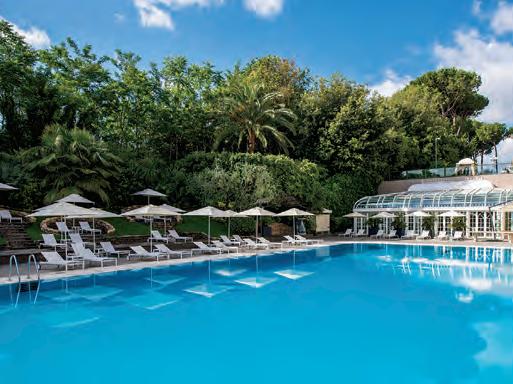
For the full flavors, aromas and sounds of Roman life, follow your nose south out of Piazza del Campidoglio and walk the eastern flank of the River Tiber for a mile until you reach the neighborhood of Testaccio. Four blocks in from the riverside is the renowned Testaccio Market, open every day bar Sunday, where 100 stalls cater to local shoppers and tastes with fresh produce. There are clothing vendors as well, but this is ideal for picking up lunch on the go from one of the variety of takeaway stalls, such as delicious, hot Roman sandwiches from Mordi e Vai.

Food, of course, is always something to celebrate in Rome, from the simple trattoria to the Michelin-starred finedining room. The Cavalieri is home to the ultimate example of the latter, existing in understated grandeur on the hotel’s top, ninth floor. La Pergola, from German chef Heinz Beck, is in fact Rome’s only Michelin three-star restaurant and the only hotel restaurant in Italy to hold three stars.

Frescoed ceilings, artworks dating back to the 18th century and elegant furnishings set the tone for the exquisite restaurant, which opens up to a roof terrace with panoramic views over the city. Opulent table settings revolve around gold-plated silverware, ready to receive

dishes created with astonishing intricacy and imagination.
Case in point: chef Beck’s “Fagottelli La Pergola,” which is his interpretation of carbonara. Instead of mixing the spaghetti into a sauce of eggs, pecorino, guanciale and parmesan, Beck encapsulates the sauce within little pasta parcels. It produces “an explosion of warm, rich flavor,” claims Beck—and it absolutely does. “My intention is to transmit emotions through harmoniously balanced aromas, flavors and colors—sensory stimuli which are intertwined and blended in suffused and refined surroundings.”
If that is your intention, Rome seems like the perfect place to start.

“AN EXPLOSION OF WARM, RICH FLAVOR.”Adriano Truscello




















Expectations for the U.S. Ryder Cup team to successfully defend in Italy this year will be high, yet clinching the Ryder Cup away from home is one of the toughest assignments in sport. The last time the U.S. won in Europe? 30 years ago, in 1993.
“They may have invented the game, but we perfected it,” were the rallying words of U.S. captain Tom Watson, standing in front of his players as they flew to England on Concorde in September 1993. Three decades later, American player Jim Gallagher Jr. admits: “Those words still ring in my head to this day”.


The only thing thicker than the fog at The Belfry in September 1993, as the 30th Ryder Cup got underway, was the tension. The previous chapter, at Kiawah Island in 1991, was the notorious, fiery “War on the Shore,” when the home team edged Europe, and two years later feelings were still raw.
U.S. captain Watson, a gentleman of golf, set out to restore cordiality, but then he broke with age-old tradition at the pre-match gala dinner and refused the request of Scotland’s Sam Torrance for the visiting team to sign his program. The snub fueled European resolve.

The opening foursomes were split 2-2, with Europe’s Ian Woosnam and Bernhard Langer dismantling Paul Azinger and Payne Stewart by a record score of 7&5, yet Tom Kite and rookie Davis Love III replied by defeating Spanish duo of Seve Ballesteros and José María Olazábal, who together were previously almost invincible. Revenge for the Spaniards was swift, as they beat Kite and Love in the afternoon fourballs, as Europe edged to a 4½ - 3½ lead after the second series.


The Saturday was vintage Ryder Cup. Europe surged ahead in the morning with three foursomes wins from their impressive new pairing of Nick Faldo and Colin Montgomerie, stalwarts Woosnam and Langer, and the Spaniards. Only Ray Floyd—at 51 the oldest Ryder Cup golfer ever—and Stewart scored for the Americans. With the score up to 7½ - 4½, the second series of fourballs was now or never for the visitors.
Corey Pavin and Gallagher Jr. eased past Mark James and Costantino Rocca—seeing Italy represented in the Ryder Cup for the first time—before Woosnam and Peter Baker surprised Fred Couples and Azinger in a 6&5 rout, when Baker holed every putt he touched. Playing his only Ryder Cup, Baker grew up 30 miles away. He won three points that week as he and the crowd spurred each other on, yet the fairytale would soon veer off script.
As the Saturday afternoon darkened the visitors found the resilience to stay in touch, with wins for Floyd and Stewart, and crucially, for John Cook and Chip Beck over Faldo and Montgomerie, at the last hole. Going into the singles, Europe’s lead was narrowed to 8½ - 7½.
With the score up to 7½ - 4½, the second series of fourballs was now or never for the visitors.
An expectant crowd of 30,000 piled into The Belfry, and the singles produced rare drama. Beck was three down to Barry Lane with five holes to play, yet somehow fought back to win, while Couples forced a half after being two holes down to Woosnam.
Then the European middle order delivered to put a home victory within reach. Montgomerie, rookie Joakim Haeggman—the first Swede to play in the Ryder Cup— and Baker all closed out points on the home green to push Europe up to 12½ points. They only needed two more.
But the Americans would not concede. Conventional thought for Ryder Cup singles is to load your form players up front to get early points and early momentum. Watson saw it differently. The fearless Stewart went out sixth— middle order—and beat James; the unshakeable Kite went out 10th and defeated Langer; while Gallagher Jr. beat Ballesteros to level the score at 12½ each.
By 1993 the magic of Ballesteros was waning yet he remained the European talisman. It was the fire of Ballesteros that lit the European Ryder Cup revival a decade before, but as Gallagher Jr. doused Ballesteros on the back nine he also beat down the home crowd, who could see American red beginning to take over the leaderboard.


With Floyd comfortably ahead against Olazábal— proving that age is just a number as he tallied three points for the week—the crucial match was contested by two rookies, Rocca and Love. It was close, with the lead switching between the two on the back nine, and when Rocca missed a short putt on 17 it was all square going up the last. Love, aged 29 at the time, played an immaculate final hole—The Belfry’s famous dog-leg par-4, which demands a second shot to clear a lake—while Rocca began to unravel.
On the 18th fairway, Love recalls how his skipper Watson came up to him. “Tom said to me, ‘We really need this point.’ I was like, ‘Thanks.’”
Love held his nerve to hole the six-foot par putt to secure the Ryder Cup. A major champion in the making, Love would play in five more Ryder Cups.
Azinger held on for a half against Faldo, and the final score was 15-13.
It will be a tough assignment for the USA again this year in Rome, but as U.S. captain Zach Johnson told Kingdom after his appointment last year, “I wouldn’t have it any other way.” —robin barwick

Not yet five years ago, conversations about golf’s future were laced with concern about a lack of interest in the sport. The pandemic changed all that, to the point where the future of the game is as vibrant as it’s been in quite some time. On the professional side, Rose Zhang is bringing a massive jolt of excitement to the LPGA, while the Great Golf Ball Debate has players and pundits buzzing (not to mention the everevolving state of men’s professional golf, which was still very much in flux at press time). Golf course design is also entering a new era, while game-changing gear is altering how we play and even what we do off the course. However things shape up, and whatever the future holds for golf, we’re excited for what’s to come.









While politics dominate the PGA Tour in an unholy, unrelenting saga, something much more wholesome, impressive and optimistic is shaping the future of the women’s side—the irresistible rise of Rose Zhang. The two-time NCAA champ turned winning pro found the time to speak to Robin Barwick.
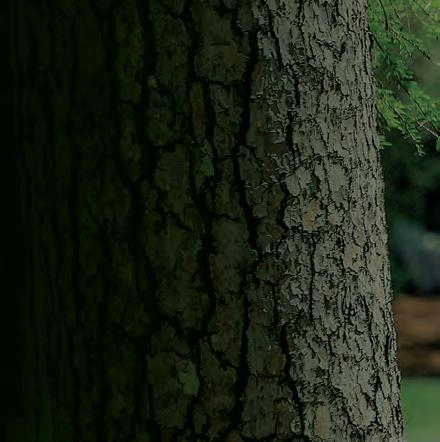


TTiger Woods talked of the importance of “learning to win,” relating in particular to golfers who aspire to play on tour. It is a strategy that worked out well for him. The teenage Woods could have competed successfully on the PGA Tour had he gone pro, but he and his family remained patient. Woods spent two years at Stanford, and in 1996 he became the first golfer to win the U.S. Amateur Championship three times in a row.
Woods won 11 of 26 NCAA tournaments as a Cardinal over two seasons, tying the school record held by Maverick McNealy and Patrick Rodgers. He left Stanford as the 1996 NCAA individual champion at the age of 20, having won eight times from 13 starts in his sophomore season. Less than a year later, he was a major champion—but that’s another story.
To write that Rose Zhang has also learned how to win doesn’t really cover it. Like Woods, Zhang played two seasons as a Cardinal, only she broke his school win record. In May, and also 20 years old, she became the first woman ever to win two NCAA Division I individual titles. She won eight times in 10 NCAA starts for the season, and she left the collegiate fold with 12 wins in two years. The only other golfer to have won eight times in an NCAA season and 12 overall is the legendary Lorena Ochoa.
After a record 141 weeks ranked No. 1 on the Women’s World Amateur Golf Ranking, the most successful women’s amateur of all time turned pro at the end of May. She promptly continued her unparalleled rise by winning on her first professional appearance, at the LPGA Tour’s Mizuho Americas Open. Not even Ochoa managed that.
Yes, Zhang has learned how to win.
Joining Zhang for her pro debut at Liberty National Golf Club in New Jersey was Stanford coach Anne Walker. “Rose went out onto the LPGA Tour, and she did tons of media on the Tuesday and Wednesday, just tons,” starts Walker, who has been director of women’s golf at Stanford since 2012. “She probably was not as well prepared as she would have liked, but to be able to go out there and put all the noise aside, and to get into a position to win, and then not just that but to get it over the line in the way she did, it makes you think that perhaps that Rose Zhang ‘X’ factor can transfer to the highest level.”
Zhang has earned a factor all of her own, the ‘Z’ factor.

The only other golfer to have won eight times in an NCAA season and 12 overall is the legendary Lorena Ochoa.
“In our sport, winning—and winning and then winning again—is so incredibly difficult,” says Walker. “This is not one team against another, this is one golfer against 143 competitors. The law of probability is that you probably won’t win, and so the fact that Rose has won so much in college is pretty unique.”

And yet, despite all the glamor and the glory, Zhang is not turning her back on her college days just yet. She has enjoyed her two years in Palo Alto, Calif., so much that she intends to combine her fledgling pro career with completing a degree in communications.
“I have spent two years at Stanford being super happy and playing on the team, and the experience has been absolutely insane and life changing,” says Zhang in an exclusive interview with Kingdom in June, literally the morning after completing her sophomore year and moving out of her dorm for the summer.
“The experience of being around people of such high caliber and of my age has definitely inspired me and pushed me to reach new heights with my game and in myself,” Zhang continues. “Around me I see lots of people multi-tasking in different ways, and it gets me to think that, why can’t I do it too? It is definitely not a common path [to remain in college as a professional athlete], and
I understand it will be very hard and it will require a lot of balancing and a lot of patience, but I think this is the right decision for me.”
Zhang’s idol, Lydia Ko, completed her degree after turning professional, and Zhang’s fellow Stanford alumn, Michelle Wie, did the same.
It brings to mind the words of the late Payne Stewart, who was on the same page as Tiger when he offered: “Stay in college. You don’t want to be 10 years out here wishing you had those two years over to be a college kid again.”
Zhang will try to balance the best of both worlds by continuing her studies, while Zhang the golfer is obviously ready for the LPGA.
Walker recalls that when Zhang arrived on campus in the fall of 2021, aged 18, she was already amateur World No. 1 and U.S. Women’s Amateur champion, and so the progress was more about the mental preparations for a professional career than they were athletic.
“There was nothing I was going to teach Rose about playing golf—that was pretty dialed,” recalls Walker. “Over the past two years we have taken opportunities for Rose to think about how can she grow, what does she do well, what could she do better, and how she needed to take the CEO seat within her game and own that CEO























seat. She needed to learn that for every decision she makes she can take input from a ‘board of directors’— and that input might vary from person to person—but at the end of the day Rose is the CEO and the professional, and she has to make the final decisions and own them with full accountability.
“It was fun to work through with Rose because I have seen her take that responsibility over the past three or four months but particularly in recent weeks, since she joined the LPGA Tour,” Walker continues. “Rose now understands more than ever what we were preparing her for.”
Walker helped persuade Zhang to join Stanford instead of USC, which is closer to her Southern California family home in Irvine, and also closer to her swing coach, George Pinnell, based in Rowland Heights. “Coach Walker has such a knack for being a team leader,” says

Zhang. “She brought together a group of elite women to play together as a team, and she is there as someone we can look up to, and I don’t think many people could do that the way she has. She has helped me work out how to go about my business in the real world, and she has been a great mentor and a great voice for me to hear.”
Part of Zhang’s personal evolution over the past two years has seen her become accustomed to the expectations that come from outside.
“When Rose arrived on campus she was already No. 1. in the world, but she was shy,” recalls Walker. “She has come to understand the role she plays, and she understands the expectations that people put on her, and she handles it like a star. Two years ago, Rose would not have thought of herself as a role model, and she was not ready to take it on, but now she understands that being a role model is an earned responsibility and a privilege
“She understands the expectations that people put on her, and she handles it like a star.”
and that it is not anything to shy away from. Once you become a role model for the next generation, you have to live up to it, and I can see that Rose does that.”
Says Zhang: “As a kid, I was intimidated by professional players, like a lot of other kids, and so I never had the balls to go up and ask a player for their autograph. If they were practicing, I respected the fact that they were doing their job. I would just watch, but now that I am a professional I want to create a space for kids who might be a little scared—like me before—and I like to ask kids how they are doing and wish them luck, and be someone who kids feel like they can approach.”
Those Zhang amateur decorations, by the way, include the Annika Award as the outstanding NCAA Division I golfer, which she won two years in a row—no surprise—and which has afforded Zhang some quality time with the Swedish 10-time major champ.
“Annika told me to smell the roses”, says Zhang, in receiving an echo of the valuable advice that was first attributed—within the golf arena—to the great Walter Hagen. “Annika said that when she was younger she had a lot going on and that she was always go, go, go, and she wishes she could have found the time to sit back and realize what she was doing and achieving at the time. I can resonate with that.”
Good for Zhang if she can achieve that, but life right now is moving at meteoric speed; roses flashing by, petals scattered in her wake. A full summer’s tour schedule is about to reach fever pitch—again—when the U.S. Women’s Open is staged for the first time upon the storied links of Pebble Beach (July 6-9), in Zhang’s home state, and on a golf course where she set the women’s course record last September in the Carmel Cup—63, nine under par.
What was that about expectations?
“Rose is bearing the burden of being the big story,” adds Walker. “Everyone wants to root for a California girl at Pebble Beach with history on the line. Women’s golf is looking for a great story, and you can just feel that there is momentum with Rose, and that people are really rooting for her and hoping she can keep the train rolling.”
It is not just women’s golf. We are all looking for— and rooting for—a great story like Rose Zhang.

“You can just feel that there is momentum with Rose, and that people are really rooting for her.”


























From the designs we play to the ways in which we navigate them, Kingdom consulted with the experts on how the golf experience will evolve.
 By Shaun Tolson
By Shaun Tolson
For the better part of the last decade and a half, restorations of Golden Age courses have commanded signi cant attention, both by golf’s contingent of passionate media members and by the course architects charged with those projects. From Pinehurst’s revered second layout to L.A. Country Club’s North Course—the latter of which recently enjoyed its 15 minutes of fame as the host of this year’s U.S. Open—the DNA of those classic courses has reminded us all that architectural concepts conceived more than a century ago are just as relevant and exciting today.

“ e things that we learned at Los Angeles Country Club helped us to become better architects in our original work because of what George omas did and how great he was,” says Gil Hanse, who led the restoration of the club’s North Course. “Courses within courses and holes that can go from being a par-3 to a par-4, those were things that we had read before, but at LACC it was the rst time we’d actually seen them implemented.”
According to Brandon Johnson, vice president and senior golf course architect at Arnold Palmer Design Company (APDC), courses currently under construction are showcasing some of those historical themes and features. ough he believes this pattern will continue, he also envisions cutting-edge technology playing a bigger role in future developments.
When APDC built the second golf course at Lakewood National in western Florida in 2019, for example, all of the dozer equipment was outfitted with GPS programs pre-loaded with the project’s mass-grading plans. “I was skeptical at first,” he acknowledges. “But once I started to see interesting shapes and landforms coming out of the ground, my mind was eased—and opened.”
Johnson also explains that a slowdown in new course development during the past 15 years provided course architects with the time to devote more attention to individual projects. As a result, he says, those architects found inspiration onsite and began to shift their methodologies, “designing while building” instead of having a “strict reliance to a plan.”
Johnson’s colleague, Thad Layton, a senior golf course architect at APDC, points to the outdated reliance on pre-designed plans as a reason why many of the U.S. courses built in the early 2000s are “pedestrian.” In his opinion, the approach is “dying a slow death,” but it remains commonplace in emerging markets. “If artificial intelligence (AI) ever takes over,” he says, “these will be the first types of architects to get replaced.”
“There’s a lot of enthusiasm for virtual golf right now—there are more people in the U.S. playing Top Golf than playing real golf courses. The way we’re going, it would seem to me that virtual golf courses are inevitable. I could see a time well within my lifetime where I’m taking my buddies to Top Golf and we’re playing a real golf course—or an imagined one—and we’re hitting real golf balls into a hologram, then watching the ball do something in that hologram. At every one of these facilities, you could have the top 10 virtual course architects. The only thing that’s real is that you hit a real golf ball. It’s Star Trek meets Top Golf.”
—David McLay Kidd, course designerOn the topic of AI, Johnson wonders if computer programs might soon be able to implement historical data from the designs of deceased course architects such as Donald Ross, Alister MacKenzie and Seth Raynor to create a new layout. “That could be scary or really interesting,” he says.
Technological aids aside, the future of golf course architecture, according to Layton, is likely to follow a singular theme: diversity. “A range of design styles, materials, processes and philosophies will yield an everincreasing variety of golf courses.”

Just like on a well-designed golf hole, where players can take several different strategies from tee to green, there will always be conflicting opinions about the various methods that exist for getting around the course. Mark Stewart, the CEO of Stewart Golf—a British manufacturer of push, remote and follow golf carts—is quick to recognize this. “Golf is a broad church,” he says. “Some golfers will always ride, some carry, some push, and the privileged few will use a caddy.”

That caddy experience—both now and going forward—includes Stewart Golf’s remote or follow electric carts, which allow players to walk a course without exerting extra effort lugging their clubs around, whether that schlepping takes the form of pulling an old-fashioned golf cart behind them or pushing it in front. The latest Stewart electric model is the Vertx Remote, a cart equipped with patent-pending Active Terrain Control technology, which measures the cart’s speed 1,000 times per second while also reacting to the terrain that it’s traversing. According to Stewart, this makes the Vertx an electric cart that’s “unrivaled in its stability and on-course performance.”
Stewart also points to a recent study that found that golfers who carry their clubs surprisingly burn about the same number of calories as those who walk the course unencumbered. The difference is the physical state that golfers find themselves in when they walk the course with an electric cart. More specifically, “It keeps heart

“Using a Stewart electric caddie provides an experience as close to a human caddie as possible, but you don’t have to listen to its stories or tip it after the round.”
—Mark Stewart, CEO of Stewart GolfLos Angeles Country Club [opposite], VERTX Remote [right] and Q Series Folded [below]




rates more consistent,” says Stewart, “which means you won’t have a thumping heart as you’re standing over a birdie putt.”
Rick Reimers, the founder, owner and inventor of Finn Scooters, concurs. Well, sort of. “I believe you should hit it, find it and hit it again,” he declares. “And the best way to do this is either walking or on a Finn Scooter.
“Everything changes on a Finn,” he continues. “You can park almost on the green or tee, enjoy more of the course and be away from your partner’s [bad] habits. Most of all, you will experience the excitement of driving an electric two-wheeler on grass in a beautiful place.”
Built around a 48-volt, brushless, planetary gear motor that delivers high torque, Finn Cycles, as the company’s two-wheeled vehicles are called, are designed so that the rider’s golf bag is secured along the bike’s centerline, which promotes riding comfort, added stability and easy maneuverability. According to Reimers, there’s an uptick in demand for his company’s scooters at golfing destinations that want to embrace and promote
fast and fun play. This includes golf resorts, public courses and private clubs; and it suggests that, in time, the future of on-course vehicle transportation could transition from four wheels to two.
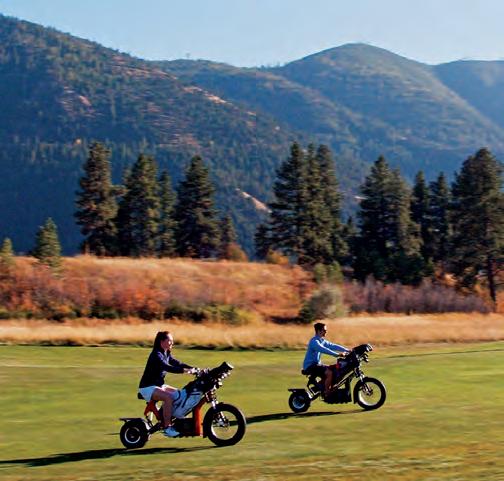
“Golf has been extremely resistant to change, but as we have seen with recent events, that dam may be bursting,” Reimers says. “Owning a Finn is almost life-changing for a lot of golfers. It becomes a major enhancement to their golf, which is the core of their lifestyle.”
GEM low-speed vehicles (LSV) are also shaking up the lifestyle of golf communities all across the country. The reason? They’re street-legal on most 35-mph roads or less in the U.S.; offer 43 inches of legroom; are loaded with customizable amenities, such as panoramic skyroofs and high-efficiency photovoltaic solar panel cells; they’re remarkably silent; and—best of all—they’re 100-percent electric, which means they emit no harmful carbon gases.
At many gated golfing communities, golf carts are the way to get around these days. Sooner rather than later, those carts could be replaced by GEM LSVs.

“If Tiger Woods wins a major riding a Finn Scooter, growth will be biblical. If that does not happen, growth will occur, but at a slower rate.”
—Rick Reimers, owner and inventor of Finn Scooters
There’s an old adage about popularity and public acceptance, which suggests that you can’t please everyone all of the time. There was a period when the private golf club model attempted to rebuke such a notion, introducing a plethora of non-golf amenities in an attempt to be the private club for all tastes and interests. Now, the future of private clubs seems tailored to niche operations. In other words, the best new clubs opening their doors are targeting specific audiences and, in turn, they’re focusing their efforts on key amenities and experiences that will satisfy those specific members and prospects.
The Dormie Network has embraced this approach, creating a portfolio of seven clubs to date, spread out across the country, all of which tap into a specific lifestyle—and are all available to a Dormie Network member. “The vision was to provide our members with a setting to cultivate relationships in an environment with exceptional hospitality, luxury accommodations, memorable culinary experiences and world-class golf,” says Mark Ruhga, Dormie Network’s chief operating officer. “The traditional national or destination club was an inspiration, but scaling the concept to allow our members multiple clubs has been the true differentiator.”
Looking to the future, it’s hard to imagine that other players won’t enter the market offering a similar membership model. With two properties in Nebraska,
as well as clubs in Virginia, Texas, North Carolina, New Jersey and Indiana, Dormie Network can deliver seven distinct club experiences, each one infused with its own authentic sense of place. But, as Ruhga acknowledges, each one is built around foundational pillars that he believes won’t change, even as new clubs are developed.
“The core purpose of the private club industry will remain consistent—recreation, relationships and networking,” he says. “The most successful clubs will focus on where they currently excel and potentially become more specialized, but the golf course itself will remain a top priority.”

“It certainly wouldn’t surprise me to see other similar concepts evolve in the future, but it is challenging to find the right mix of courses with varied geographic locations and proper amenities.”
—Mark Ruhga, COO of Dormie NetworkEvan Schiller Photography
Welcome to the dream destination for golf enthusiasts and those seeking exclusive luxury. AWA Corasol is a real estate development located in one of the fastestgrowing and most prestigious areas in the Riviera Maya, surrounded by the natural beauty of pristine beaches and a worldclass golf course, Gran Coyote Golf.
At AWA Corasol we offer an exclusive selection of pre-sale residences designed for those who desire a sophisticated and privileged lifestyle. Our properties boast breathtaking views, luxurious finishes, more than twenty amenities and cutting-edge technology, including solar panels, providing you with an eco-friendly and sustainable living experience.
Experience exponential growth and value in the Riviera Maya real estate market with AWA Corasol. Don’t miss the chance to own a piece of this luxurious oasis.




Mark Townsend considers the ongoing saga over proposed golf ball restrictions and mulls over a few other equipment trends.
On March 14—notably two days after the PGA Tour’s showpiece at Sawgrass, The Players Championship—golf’s rule makers announced that they would be putting extra limits on how far the golf ball will travel.
If adopted, this will be introduced courtesy of a Model Local Rule in 2026. Put simply, conforming golf balls under this MLR must not exceed 320 yards at 127 mph clubhead speed, which will bring about a reduction of 14 to 15 yards.
We are currently in the middle of a five-month “comment period” from those in the industry. While there is much determined activity behind closed doors, Titleist and TaylorMade are both unwilling to say any more beyond their original statements of disapproval. Said David Maher of Titleist: “The proposal of golf ball bifurcation is in many respects a solution in search of a problem.”
Maher refers to the point that recreational golfers would not be affected by MLR so the proposed rule would effectively introduce bifurcation—one ball for pros, another for amateurs—and this is the last thing the manufacturers want. For partly aspirational and partly financial reasons, they want all of us to play the same ball.
The bulk of tour pros also don’t want change, although the PGA Tour poster boy Rory McIlroy bucked the trend. He told the No Laying Up podcast: “I think you’re going to see people with more well-rounded games succeed easier than what the game has become, which is a bit bomb and gouge over these last few years.”



Given that it’s golf, it’s complicated. All four men’s majors are run by different organizers. The game’s governing bodies—the USGA and R&A—run two of them. Part of their remit is to both protect the game and the courses, and the MLR is their joint proposal.
Augusta National recently purchased land from the adjacent Augusta Country Club to extend its par-5 13th. Needing bigger footprints for golf courses and all the agronomy that comes with it is not good. A rollback would hugely benefit the playing of Augusta National, and likewise the Old Course, St Andrews. In recent opens on the Old Course, the R&A has resorted to using tees from adjacent courses to stretch out holes, and despite this there has been ungodly talk of 59s. Last year in The Open, there were six-hour rounds, with slow play compounded by long waits on tees by players waiting to drive on par-4s with reachable greens.

The USGA’s showpiece, the U.S. Open, will return to Merion in 2030. Merion measured under 7,000 yards for the 2013 U.S. Open and has nowhere else to expand, so the USGA will want golfers to play a distance-limited golf ball there.

A rollback would hugely benefit the playing of Augusta.
Englishman Robert Rock, twice a winner on the European Tour, is one of the game’s more open-minded thinkers. He spent most of his career as a free agent with a bag full of mixed clubs. How does he see a shorter ball impacting the professional game?
“The first [Titleist] ProV1 in 2000 was a gamechanging moment,” he says. “Anything since has been a mild modification. Something needed to be done in those early years, as that ball was night and day better than anything else. I recently played a round with the first ProV1 and I barely noticed the difference [between that ball and the latest generation of Pro V1s].
“The manufacturers now offer plenty of options in terms of spin and launch, so they’ve got to drastically reduce the actual capability of the ball speed. Whatever plays out, it’s an equal adjustment for everyone, and the best players will still be the best players. It will be like turning your TrackMan on and taking off five percent.”
One area, interestingly, which hasn’t been discussed as much is that the MLR might just put more emphasis on the short game.
“If the ball comes off softer and we get more spin on it, then we might see a bit more creativity,” suggests Rock. “If there’s more shaping of shots and short-game skills, that would be really cool.”
One thing is for sure: There will be plenty more twists and turns in the trajectory of this issue in the months and years ahead.
For the first time, Fujikura’s flagship Velocore Technology has been integrated into a graphite shaft for irons. The technology was initially introduced in the Ventus and Ventus TR, the shafts trusted by many of the world’s top players, including Rory McIlroy and Tiger Woods. The genius in this new Axiom graphite iron shaft is a three-length system that creates specific weight and flex-matching for long, mid and short irons, which allows club builders to provide an exact fit.
If golf ball flight is to be limited, emphasis on driver technology will become more important than ever to manufacturers. The Callaway Paradym features carbon fiber on the sole and crown, while the TaylorMade Stealth 2 has it in the face. TaylorMade introduced the “carbonwood” in its original Stealth driver, due to the strong and lightweight nature of carbon. The Stealth’s face weighs only 26 grams, which is 40 percent lighter than a titanium face of the same size. With the Callaway Paradym, the center section features no metal, so the clubhead weight has been shifted, in order to produce a higher moment of inertia at impact and increased ball speed.
Cobra is not renowned for putters, but it has been making some progress in the past couple of years through 3D printing. This process can create a lattice nylon structure that sits in between the crown of the putter and the chassis. Why nylon? Nylon is lighter than aluminum, and when the central part of the putter is lighter, the relative weight of the putter head moves to the perimeter to create more forgiveness and stability.
Many companies are now using graphite putter shafts. KBS has provided the stock shaft in the TaylorMade Spider for years, and the GPS is the brand’s first graphite putter shaft. It’s certainly eye-catching, with eight standout colors and, for the traditionalist, a silver option with a gloss finish that resembles steel. The GPS is a low-torque performance shaft that should help the face to resist twisting on impact, which improves the MOI and keeps the face more in line with the target.


There is real momentum for improving the sustainability of professional golf tournaments, and the Waste Management Phoenix Open is taking the lead.
Despite the ruckus, the Waste Management Phoenix Open sends zero waste to landfill.

They can cram 20,000 screaming, cheering, singing, booing golf fans around the par-3 16th at the Waste Management Phoenix Open at TPC Scottsdale, creating one of the most notorious spectacles on the PGA Tour. But all that noise—and they really do make a lot of it—drowns out another, much more important feature about this tournament: The Waste Management Phoenix Open is the self-proclaimed “Greenest Show on Grass.” In fact, despite attracting hundreds of thousands of spectators annually, the tournament achieves one of the gold standards of sustainability: It sends zero waste to landfill.
Reaching “zero waste” takes planning, because it requires careful management of all materials that come onto the site for the tournament in the first place. Take the beer cups. Examples at other events are typically made from single-use polystyrene foam, but at the Phoenix Open they are made from sugarcane fiber, cornstarch and recycled fiber, which means the empties can be composted. In total, the Phoenix Open diverts around 1,000 tons of waste from landfill each year to some form of re-use.
Waste Management has brought in other initiatives too, such as taking wastewater from the kitchens and bars and reusing it in the portable restrooms, while 100 percent of electricity purchased for the event comes from renewable sources. Thanks to its efforts, the Phoenix Open this year became the only tournament to have received certification from the GEO Foundation for Sustainable Golf for the seventh time.
“The big challenge to a sustainable tournament is what to do with all the materials left behind at the end,” starts Roddy Williams of the GEO Foundation, a non-profit that supports tournaments and organizations in the golf industry. “Sending to landfill is the worst option—that is littering the environment—so finding a secondary use for materials is what more tournaments are now embracing. The whole process of recycling at a tournament the size of the Waste Management Phoenix Open is really impressive. It has the biggest spectator attendance on the PGA Tour yet produces zero waste to landfill.”
The Phoenix Open is not alone in taking strides to cut waste and minimize the impact of professional golf tournaments. Additional examples can be seen from the coast of Northern Island to the desert of Dubai.
The R&A introduced a standout initiative at The Open at Royal Portrush in 2019, when it ceased the procurement and supply of drinking water in plastic bottles. Instead, it set up water refilling stations around the golf course and sold reusable stainless-steel water bottles. The R&A estimates it has prevented the use of 400,000 plastic bottles since 2019.
Mercedes-Benz, a patron of The Open, helps to minimize the environmental impact of the championship by bringing a fleet of electric cars each year for the transportation of players and officials. The Mercedes-Benz fleet is powered partly by solar energy and partly by generators that are fueled not by traditional diesel, but by hydrotreated vegetable oil (HVO), a sustainable biodiesel.
Omega European Masters
Cotton drapes are used in many of the temporary structures at golf tournaments. At the Omega European Masters in Switzerland, on the DP World Tour, the cotton drapes are cut up at the conclusion of the event and repurposed as cloths and donated to local garages and workshops. It is a simple solution, keeping more waste out of landfill and emphasizing the importance of tournaments liaising with local community groups to ensure all leftover fabrics, carpets, building materials and non-perishable foods find a second life.
Dubai Desert Classic
Harnessing solar power makes sense in the desert climate of the Middle East, and the Hero Dubai Desert Classic is taking full advantage of this natural power source. For 2023, the DP World Tour event at the Emirates Golf Club featured a media center powered by solar panels laid out on the center’s roof. Hospitality units out on the golf course were powered by portable solar power units that unfolded to produce a field of panels measuring 325 feet long and 33 feet wide.
“A lot of good work is being done, and more tournaments are getting onboard with sustainability and steps they can take,” says the GEO Foundation’s Williams. “Tournaments are realizing that many steps are easily achievable and that they can even save money as well. And technology is advancing all the time, so solutions continue to evolve.” —robin barwick
Oregon’s “other” epic golf destination serves up much more than just great golf.
 By Shaun Tolson
By Shaun Tolson

Halfway through lunch at Sunriver Brewing Company’s gastropub in Bend, Oregon, a member of the wait staff strikes up a conversation with a golfer in our group whose hat bears the logo of Bandon Dunes’ par-3 course.
“Love your Preserve hat,” the server begins. “I was out there a couple weeks ago, and it was just heaven.”
Such is the reality of travel-worthy golf in the Beaver State. For the better part of two decades, Mike Keiser’s influential resort along the southern coast, about 165 miles from downtown Bend, has become synonymous with championship-caliber golf in Oregon. Chances are, if you’re planning an Oregon golf trip and the impending journey makes its way into conversation, assumptions will be made it’s to Bandon Dunes.
And yet, Central Oregon is a comparable nirvana for travelers who dream about hammering drives down tightly mown fairways and stroking putts on smooth, fast-rolling greens. Thirty golf courses exist within 30 miles of downtown Bend, the vast majority of which are open to the public. Better still, many of them transport golfers to distinct landscapes and onto diverse terrain, with several delivering dramatic vistas of the nine nearby mountain peaks.
Of course, a Central Oregon golf getaway is not just about the golf. Exceptional food and world-class beer are always at the ready to round out a trip to Bend—to the point where some golfers may have difficulty deciding which of those three experiences left the more indelible impression. As with any golf journey, however, the travel planning always begins with the golf that’s to be played, so it’s best we start there.
If you put stock in any of the prominent golf publications’ annual lists of top-ranked American courses, you’ll find as many as eight Oregonian layouts inside the top 100 open to the public—three of which are located in or around Bend. The most celebrated of that bunch is the Nicklaus Course at Pronghorn Golf Club, a former private, highdesert course that’s now open for public play. Built in 2004, the 7,379-yard layout delivers a rollercoaster of mixed emotions and showcases the Golden Bear both at his best and worst as a course designer. Almost assuredly, first-time visitors to the course will walk off the 8th green cursing Nicklaus’ name. Stretching beyond 600 yards from the back two tees, the downhill par-5 plays slightly uphill to begin and requires players to position their drives in an area that not only pinches in on both sides but is punctuated by four steeply faced bunkers. From there, the fairway narrows considerably through the middle section of the routing before a large pond emerges down the right side.



The 12th and 13th holes, by contrast, are two masterfully designed short par-4s that challenge players in starkly different ways. Much of the landing area on the 342-yard 12th hole, for example, is obscured by a rocky outcropping on the left. Players who ignore the temptation to drive the elevated green and instead hit tee shots that leave between 80 and 100 yards in will be rewarded with a level lie and a manageable approach. On the 13th, a broad water hazard guarding the inside edge of the angled fairway is the only worrisome hazard. That hazard extends all the way to the front edge of the green, but in this instance, what you see is what you get, and it’s up to you to decide how daring to be off the tee.
A 40-minute drive south brings golfers to Tetherow, arguably Central Oregon’s most luxuriously appointed golf resort—and most misunderstood course. Designed by David McLay Kidd, the 7,283-yard layout has an undulating topography, fescue-planted fairways and firm and fast conditions that inevitably draw analogies to courses in McLay Kidd’s Scottish homeland. But according to the architect—who now makes his permanent home in Bend—it’s not that simple.

“It’s so much more dynamic and there’s so much more depth to the strategy that speaks to golf from where I’m from,” he says, comparing Tetherow to traditional parkland layouts. “If you’re playing your average parkland golf course—as long as you hit short grass off the tee—you can play into greens and maybe get your ball to stop. At Tetherow it just doesn’t happen like that. You’re not going to be able to hit a mid-iron and stop it quickly, so you really have to think about where the pin is and then where you are in the fairway in order to get that ball to come to rest somewhere close to the hole.”

“If they’re not somewhat prepared for it, it can take them by storm.”
—David McLay Kidd
McLay Kidd’s best advice for players knocking it around his track is to take one more club than they need on their approach shots but to ease back on their swing speed. “By doing so,” he explains, “you’ll take spin off the ball, and the ball will be more likely to run and bounce and roll.”
It’s sage advice, especially for those who are experiencing the course for the first time. “I try to tell them that this might not be like anything they’ve ever played before,” he says. “If they’re not somewhat prepared for it, it can take them by storm.”
Other standout courses in the Bend area include Glaze Meadow at Black Butte Ranch, a layout that offers dramatic views of surrounding mountain peaks, and Crosswater at Sunriver Resort. At the latter, the Big and Little Deschutes rivers routinely meander alongside and occasionally bisect the fairways of the Bob Cupp–designed course. At some point throughout your round, should you find yourself facing an all-or-nothing scenario, take solace in the fact that the climactic final charge in the 1969 John Wayne western True Grit was filmed in the meadow where the course now resides. If nothing else, a glancing thought of the Duke might offer the boost of confidence you need to pull off that heroic shot.

At a later point on our trip, my travel buddies and I are on the hunt for a cocktail bar—a hidden one to be more specific—and as any good speakeasy goes, this one is proving difficult to find. Our host leads on undeterred; yet, as one of the few following in his footsteps, I can’t help but think that not only are we not getting any closer, we may be moving farther away.
We first climb a flight of stairs at McMenamin’s Old St. Francis School in Bend—a 1936 Catholic schoolhouse turned quirky hotel, circa 2004—then traverse a long, wood-paneled hallway lit by artfully shaped ceiling lamps, and eventually come to another stairway where the process repeats itself. It’s been almost two decades since I last was a college student, but this journey has all the makings of an undergrad’s quest to find that elusive upperclassmen’s party.
Like its beers and breweries, Bend offers something for just about everyone.Visit Central Oregon
Finally, we arrive at a door marked Broom Closet. Inside, a dozen or so vintage, long-bristle brooms hang from the walls. The faint din of laughter and conversation can be heard, though we’re seemingly the only ones in this cramped space. As we narrow in on the source, we come to a wall that hinges inward to reveal a sparsely lit, woodpaneled room decorated with framed rock album cover art.
Those who seek out this bar don’t come for the ambience, however. They come for the cocktails, which include—among others—the Lion’s Tail (Rittenhouse rye, allspice dram, lime juice and cinnamon), the College Old Fashioned (Buffalo Trace, banana liqueur, Jägermeister) and the Hivemind (mezcal, lemon juice, Gran Classico Bitter liqueur and honey).
Equally satisfying cocktails are served at Sunriver Resort—more specifically at the Owl’s Nest, an old sports bar that recently benefited from a redesign and now operates as more of a gastropub. And while Bend is undoubtedly a gastropub type of town, it is not without its fine-dining options. At Tetherow Resort, if you plan ahead and book a private dinner, head banquet chef Amanda Woodward will prepare a four-course meal to remember, with dishes that might include wagyu tartar, a king crab Caesar salad and Chilean sea bass with Ossetra caviar.
Of course, if greater Bend is known for anything aside from its great outdoors, it’s the award-winning beer crafted from any one of the area’s more than 30 breweries. The aforementioned Sunriver Brewing shines brightest
for what it calls its Haze Factory, a rotating selection of more than a dozen hazy IPAs, all of which measure in at less than 7% ABV, an important detail considering each offering in the lineup is easily crushable.

In downtown Bend, the Deschutes Public House offers up almost two dozen beers on tap at any one time, including its most popular (and best) offerings—Fresh Squeezed IPA, Black Butte Porter and Obsidian Stout. If you’re looking for some grub to pair with the ice-cold pint that you’ve ordered, don’t pass up the Elk Burger with grilled jalapeños.
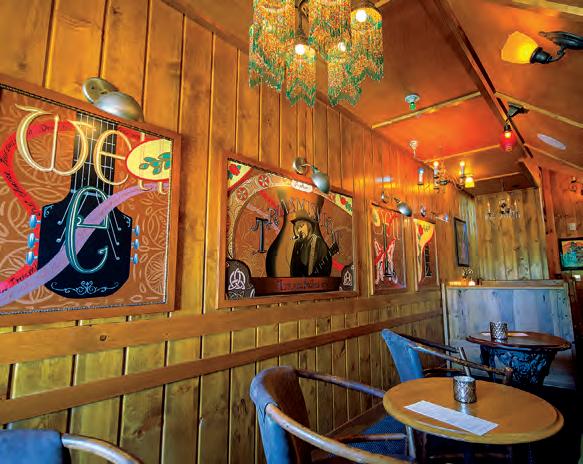
If there’s a single craft beer producer in Bend that’s not to be missed, it’s Crux Fermentation Project. Now in its second decade, the brewery offers more than two dozen beers on tap daily, most of which are as interesting as the establishment’s locale—a former AAMCO Transmission plant. Standouts from my late spring visit included Tangy Boomerang, a fruited Gose brewed with lactose that will easily convert sour beer skeptics; Gypsy Coolship No. 5, a barrel-aged farmhouse ale characterized by a rounded tartness; and Slow Rush, a complex and smooth bourbonbarrel-aged coffee imperial stout that drinks much easier than its high alcohol content would suggest.
Like its beers and breweries, Bend offers something for just about everyone, from skiing and rock climbing to live music and bar hopping. The region’s variety is especially pronounced for golfers, who enjoy a collection of courses that are as diverse and dynamic as any in the Pacific Northwest—yes, even including those found 165 miles away at Oregon’s most famous golf destination.

Summer is synonymous with adventure—even for those of us who aren’t super adventurous. Whatever your threshold for outdoor extremes, these destinations and experiences— from heli-trekking in Alaska to stargazing in Israel—will have you celebrating the season in appropriate style.
By Bruce WallinWhere: Perched spectacularly atop a cliff overlooking the border with Jordan, this 60-room hideaway is as serene as its setting in the desolate southern reaches of Israel’s Negev Desert.

Why: Opened in the summer of 2021, this still off-the-radar retreat is the perfect complement to a few days of excitement, culture, haute cuisine and history in Tel Aviv and Jerusalem. Adventures at Shaharut need not be arduous and might simply entail a “hike” from your suite to the spa or pool. Jeep safaris and stargazing excursions, however, should not be skipped, nor should the elaborate breakfast spreads served with stunning views of the Arava Valley.
Who: Shaharut welcomes children 12 and up, but it’s at its best as a haven for couples, who quickly embrace the slow pace, silent nights and barren beauty of the Negev.
Where: It’s not hyperbole when The Resort at Paws Up calls itself “America’s Private National Park.” The 37,000-acre working cattle ranch in Montana sets the prototypical Big Sky Country scene, with green pastures, forested peaks and 10 miles of trout-filled river. Among the luxury camping and residential options at the resort, the new Green O is an intimate outpost with 12 contemporary accommodations that include four treehouses.
Why: A sophisticated spin on the Montana wilderness, the Green O is as alluring to foodies—with an excellent restaurant from executive chef Brandon Cunningham— as it is to outdoors types. Wellness and spa experiences pair peacefully with pursuits ranging from river rafting and horseback riding to archery and sporting clays.
Who: The Green O is adults-only, so leave the kids at home—or put them up with the grandparents at one of Paws Up’s other camps—and enjoy the tranquility of the great outdoors.

Where: Six lakeside cabins surrounded by 1 million acres of wilderness amid the Alaska Range and Tordrillo Mountains in southcentral Alaska. e lodge is located on mile marker 194 of the famed Iditarod Trail and yet, for non-mushers at least, is accessible only via oat plane or helicopter.

Why: e luxury adventure company Eleven just took over Winterlake and is actively expanding its already-impressive roster of outdoor excursions. e out tter, which also operates lodges in Iceland, Colorado and elsewhere, will debut new heli-skiing adventures this winter. For summer, options range from heli-hiking and whitewater ra ing to y- shing, canoeing on the lake and foraging for native greens and berries. Who: Outdoor-sports enthusiasts and nature lovers who are happy to pay (summer rates start at $8,400 per person for three nights) for a highly customized and exclusive wilderness experience.

Where: e 20-passenger Evolve debuted in January as the newest luxury yacht in the Galápagos Islands from the Ecuadoran-owned Ecoventura. e boat o ers seven-night, expertly guided journeys that explore a variety of islands in the archipelago and the incredible diversity of wildlife on land and at sea.
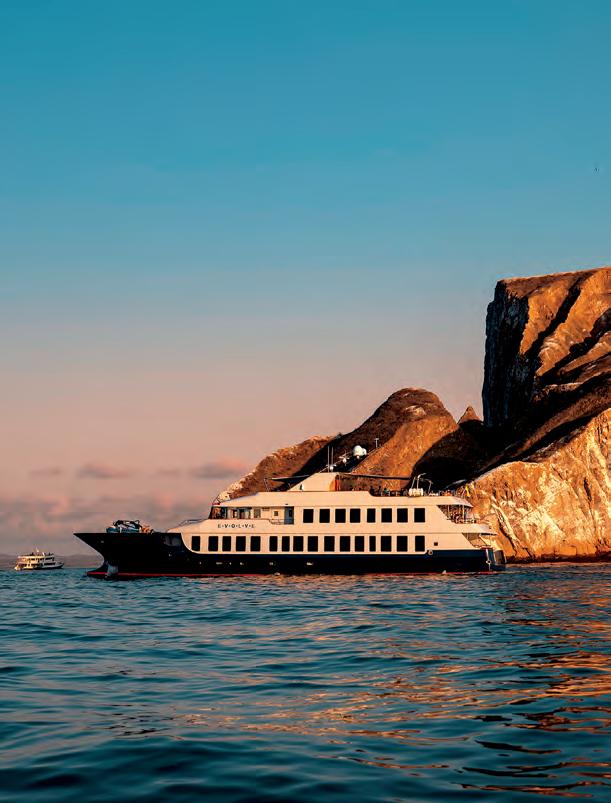
Why: e Galápagos are best explored aboard a small luxury cruise ship, from which the majesty of the wildlife can be experienced in a more intimate environment. Snorkel with sea lions and penguins, stroll along a pristine beach to spot blue-footed boobies and hike the mountainous interior to come face to face with giant tortoises. At the end of the day’s excursions, retire to the top deck to savor sunset cocktails and the knowledge that you get to do it all over again tomorrow.
Who: A Galápagos adventure on Evolve is a highly active experience, so this is not your stereotypical cruise-ship crowd. Families with older children (8 and up is best), adventurous couples and friends—basically anyone who loves wildlife, doesn’t mind a rugged hike and likes getting in the water.
Where: Originally opened in 1891, the Union Øye re-emerged last June after a full restoration by the Nordic adventure company 62ºNord. The stately lodge is surrounded by mountains, valleys and fjords in western Norway.

Why: Channel your inner explorer by staying in a suite once occupied by Roald Amundsen, one of many legendary past guests of this historic property. For a modern Norwegian adventure, do like the locals do and go wild swimming in the fjords. Cruises and kayaking trips through the waterways, hikes in the adjacent mountains and cycling excursions are also on hand.
Who: Everyone from avid adventurers to armchair explorers and history lovers will feel at home at the Union Øye.

Where: Opening this summer, this Great Plains Conservation safari camp is set on a small island in Botswana’s Okavango Delta, one of the few places where you can spot the rare sitatunga aquatic antelope. The camp will include a two-bedroom suite built on an elevated railway sleeper deck and spanning more than 6,500 square feet.

Why: The Okavango is renowned as a safari destination for good reason. Not only is it one of sub-Saharan Africa’s most wildlife-rich regions, but its floodplain terrain can be explored by Land Rover, foot or, most thrilling of all, boat. However you set off on safari, expect to see every animal on your wish list and then some, all in a liquid landscape like no other.
Who: Anyone who has dreamed of going on the ultimate African safari, especially multigenerational families looking for the trip of a lifetime.









The long, sun-splashed days of summer have finally arrived. With them, the season’s bright, fresh flavors are not only at our doorstep, they’re overflowing from our cocktail shakers and mixing glasses, too.
In search of three compelling libations for summer, we ventured to a surprising locale that, ironically, has never been kissed by the sun. Hidden away behind a secret bookshelf door, the new Bandista bar brings an honest speakeasy vibe to the Four Seasons Hotel in Houston. Comprising only 20 seats, the dimly lit cocktail den sparkles for its creative takes on classic recipes, as well as its inventive original concoctions.
“We’ve got three of the best bartenders in the city,” says Johnathan Jones, the hotel’s beverage director. “They put on a show each night for the eight seats at the bar, and we jokingly call it the lab because we’re like mad scientists back there. We love to showcase off-the-menu creations.”
Bandista’s on-menu cocktails are no less attentionworthy. In fact, the following trio of cocktails—one riff on a classic and two modern conceptions—showcase the vibrancy of quintessential summer flavors but deliver them in elegant, well-balanced forms. “They’re bright and refreshing and as summer as can be,” says Jones. “In fact, if I sip on one at any other time of the year, that bright, refreshing nature takes me right back to summer.”
• 1 oz. Pimm’s No. 1 liqueur
• 1 oz. Komasa gin
• .5 oz. lemon juice

• .25 oz. rich simple syrup (2 parts sugar to 1 part water)
• 1 teaspoon Mango Tango tea leaves (recommended vendor: Tea Sip)
• 2 dashes Scrappy’s Lavender bitters
• 1 bottle (6.8 oz.) Fever-Tree Cucumber Tonic
In a porthole decanter, arrange seasonal fruit and flowersin an attractive pattern, then add the Pimm’s liqueur, gin, simple syrup, tea and bitters. Let steep for 5 minutes. In a separate, pourable glass vessel, combine the tonic water and lemon juice. Finally, pour the decanter mixture into a Collins glass filledwith ice, then top off with the tonic mixture, adjusting to taste. Garnish with a cucumber ribbon and lemon twist.

• 1.5 oz. Goslings Family Reserve Old Rum
• .25 oz. St. George Aqua Perfecta Basil Eau de Vie
• 1 oz. Fields syrup*
• .75 oz. lime juice
• 1.5 oz. Cabernet Sauvignon (bold in style, like Groth)

Combine first four ingredients in a shaker tin with ice, shake well, then strain into a rocks glass with a large cube. Top with a carefully poured float of red wine.


*Fields Syrup
• 400 g sugar
• 240 g water
• 280 g fresh strawberries
• 30 g aged balsamic vinegar
• 25 g Fernet-Branca


Combine sugar and water in a medium saucepan and cook on low until sugar has fully dissolved. Transfer syrup to a bowl and refrigerate until chilled. In a blender, combine the cold syrup, strawberries, balsamic vinegar and Fernet-Branca and blend on high until homogenous. Strain through a chinois, then transfer to an airtight container and store in the refrigerator (will keep for up to two weeks).

*Crime Syrup
• 8 oz. rich simple syrup (2 parts sugar to 1 part water)
• 8 oz. passion-fruit puree (recommended brand: Boiron)
• 15 oz. can of Coco Lopez cream of coconut
• 2.5 g dried kaffir lime leaves
In a blender, combine all ingredients and process until smooth. Transfer to an airtight container and store in the refrigerator (will keep for one month).
• 1.5 oz. Cincoro blanco tequila
• .5 oz. Kalani coconut liqueur
• 1 oz. Crime syrup*
• .75 oz. lime juice
Combine all ingredients in a shaker tin with ice, shake well, then strain into a wooden Tiki mug filledwith crushed ice. Garnish with pineapple fronds, a lime bowl filledwith over-proof tequila, a sprinkle of toasted coconut and and a dusting of ground cinnamon.









Two chalkboards bookend either side of the lacquered bar top inside the main clubhouse at Copal Tree Lodge in southern Belize, upon which appear the names and ingredients for 15 cocktails. Some are shaken with allspice or sage leaves; others include freshly squeezed pineapple juice or hand-cut chunks of watermelon; and some are sweetened with a variety of infused syrups, including fresh ginger and vanilla. Yet, all are linked by their foundational spirit, Copalli Rum, which is distilled on property, just three-quarters of a mile away from the luxury eco lodge’s main clubhouse.
Once a more modest shing retreat, Copal Tree Lodge has evolved over the years and today attracts a diverse group of guests. Some still seek out the Orvisendorsed lodge for the chance to dri along the Rio Grande, casting ies through the mangroves for tarpon and snook, or to stalk a trophy bone sh in the shallow ocean waters that abut the white sand beaches of nearby Sapodilla Cayes. Others are attracted to Copal for its remoteness and proximity to the lush Belizean rainforest—the property is surrounded by a 12,000-acre nature reserve. But there’s a segment of the lodge’s guests who are also drawn to the property for its 3,000-acre organic farm, including the rum distillery (also organic), which spans about 114,000 square feet. (Yes, resort guests can enjoy guided rum tastings and distillery tours.)
e Copal Tree Distillery may be relatively new— the rst batch of rum owed from its stills in 2017—but there’s a deeper history to rum-making on the land. During the 1860s, in the immediate a ermath of the American Civil War, Confederates from Alabama and Texas settled in the region to raise cattle, grow sugar cane and produce rum. In time, Belizean-born descendants of those families planted 80 acres of cane and built the Rocky Run Rum distillery, which produced rhum agricole—rum made from sugarcane juice rather than from molasses—for the better part of three decades before shutting down in the late 1970s.

A young organic distillery in Belize— and the eco resort at which it’s based— is shaking up the landscape of Latin American rum.
e Copal distillery also produces rhum agricole, but that’s where any comparisons between Copalli and Rocky Run end. Cra ed by president and master distiller Ed Tiedge, Copalli is bright, vibrant and a qua able homage to the hundreds of acres of organically cultivated sugarcane that grow almost in the distillery’s shadow, as well as at o -site locations nearby. “Our role as the rum makers is to transition those avors from the eld to the bottle, to not mess up what the farm has created,” Tiedge says. “ at’s really the secret—exceptional sugarcane juice. You have to start o with a high-quality product in the eld, and if we’re good stewards of that juice at the distillery, you’re going to get a pretty good-tasting rum at the end.”
As Tiedge acknowledges, Copalli Rum is an agricultural product, which means loyal consumers may notice slight discrepancies from year to year. “ e rum that we make this year is a true re ection of what we harvested in 2023, and that will be slightly di erent in 2024,” he explains. “ at’s the beautiful part of it.”
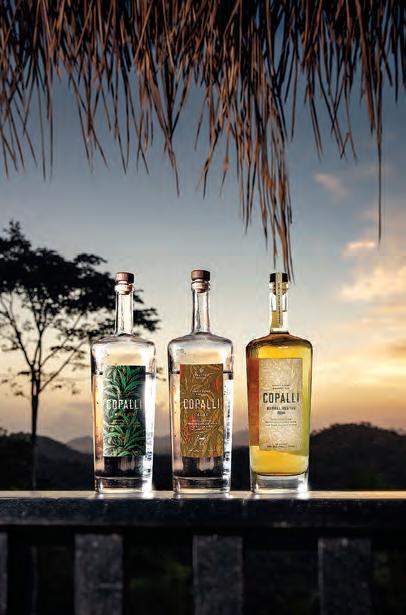


It’s no coincidence that Tiedge has prior experience cra ing distilled products from ingredients whose quality can vary greatly from one harvest to the next. He was hired as Copalli’s master distiller largely for that reason. Years ago, Tiedge received his distillation and fermentation training at Domain Prive, a family-owned French Cognac house, and the American transplant quickly observed that the most celebrated Cognac producers were, rst and foremost, those who each year cultivated the best grapes. It didn’t hurt that those chateaux also relied on highly skilled winemakers; but those winemakers’ talents shone brightly only when they had exceptional raw materials at their ngertips. “ at experience guided me on what to do here to produce a really superior product,” he says.
As for Copalli Rum’s product line, Tiedge and his team are currently bottling and selling three expressions.
e white rum, a blend of two spirits distilled in both pot and column stills, is slightly grassy on the nose, with an almost savory character balanced by notes of green apples, lime zest and banana. Flavors of vanilla,
“Our role as the rum makers is ... to not mess up what the farm has created.” —Ed Tiedge
Copalli is a burgeoning mainland rum producer in Latin America, but the region is home to several other longstanding distilleries of exceptional repute. If elegant, well-aged sipping rums are what you’re after, the following expressions produced by a trio of established mainland distilleries are certain to satisfy.
Santa Teresa 1796
Crafted using a traditional solera method—a process that marries a portion of the distillery’s oldest stock with its youngest blends—this dry Venezuelan rum is defined by an eclectic assemblage of flavors: dark chocolate, cinnamon, prunes and hints of honey.
Flor de Caña 25

This single-estate rum from Nicaragua pours a delightfully dark amber, which reflects its full-bodied nature. On the nose, aromas of Christmas cake dominate—dark brown sugar, warm baking spices, stewed fruits and hints of vanilla. Complementary flavors follow on the palate and linger there thanks to the rum’s long, warming finish.
Ron Zacapa Edición Negra



Comprised of rums as young as 6 years and as mature as 24 years, Ron Zacapa Edición Negra showcases the flavor of the double-charred American oak casks in which it’s aged—vessels selected as a tribute to the many volcanoes in Zacapa’s homeland of Guatemala. Predictably, this rum delivers spicy, smoky flavors that are balanced by notes of chocolate and dried fruit.
cardamom and a hint of black pepper largely de ne the taste of this unaged rum, which makes a delightfully smooth daiquiri.
e barrel-rested rum, a double pot-distilled spirit, spends slightly less than a year in ex-bourbon barrels. Because of that, the rum introduces many of those oak cask aromas and avors—vanilla, to ee, butterscotch and a light wood char. In Tiedge’s opinion, this rum mixes well as the foundational spirit for a negroni, though the resulting cocktail drinks closer to a hybrid of a negroni and a boulevardier. It’s richer and rounder than typical gin-based negronis but smoother than a typical boulevardier. It’s not di cult to imagine this rum serving as an elegant Cognac substitute in a sidecar, as well.
Arguably, Copalli’s most compelling o ering to date is its cacao rum, which is made by steeping roasted cacao nibs in a double column-distilled unaged rum for several weeks, then redistilling the liquid in a pot still for added depth of avor. e resulting spirit delivers an aroma that rivals warm melted dark chocolate, with comparable notes on the palate balanced by a subtle herbaceous quality. Replacing vodka with Copalli Cacao Rum in an espresso martini creates, in Tiedge’s estimation, “a transformative drink,” but we’re also quite fond of using the rum in tandem with an easy-drinking bourbon to create a chocolate old fashioned.
Since its launch, Copalli has steadily increased its production. is year, the distillery is likely to produce about 42,000 cases of rum, though Tiedge acknowledges that it wouldn’t be di cult to more than double that output. As for what’s to come, consumers can likely expect additional avored rums, as well as older expressions, though Tiedge believes that the apex of maturation for Copalli’s rums may peak at 8 or 10 years given the environment in which those spirits are aged and the accelerated extraction of avor from the barrel that occurs (as well as the evaporation that takes place). And in the same way he strives not to “mess up” his ingredients during distillation, Tiedge is taking a cautious approach to aging Copalli’s rums.

“I think you’ll nd a lot of people say that many bourbons much older than 10 years or 12 years are probably past their peak,” he says. “Will the peak of avor be 10 years for us? I don’t know; we’ll have to wait and see how those rums taste when we get there.”


It’s a good time to like fashion and golf. As the game has expanded to reach more people, these new players have brought different perspectives and personal styles that have propelled golf clothing into new categories. Sneaker culture, streetwear— if a style is in fashion, chances are you’ll find a version of that style on the course. Even high fashion is having a golf moment, with a handful of luxury labels introducing dedicated collections that go far beyond simple polos. Here, we present five brands that are taking golf style to new heights.
Gatsby
It’s rare to find a brand that has an equal understanding of golf and the nuanced design and fabrication so critical to luxury clothing. The Italian brand Gatsby brings both worlds together, based around a simple premise: that fine tailoring works just as well on the course as it does off. Gatsby produces a large yet considered collection of on-course clothing that pairs perfectly with a full offering of sportswear and tailored clothing. Taking inspiration from iconic photos of the golden age of golf, the brand emphasizes evolved and classic silhouettes, with no expense spared when it comes to materials, craftsmanship or details. gatsbysport.com

When PGA Tour player Keith Mitchell’s contract with Nike expired, he had a radical idea: just wear regular clothes. A long-time customer of the beloved Atlanta tailor Sid Mashburn, he worked with Mashburn to develop a line that would not only elevate his game, but would push him to the top of the tour’s best-dressed list. While most everyone in golf is focused on performance fabrics, the Mashburn golf line features high-twist wool dress pants, cashmere sweaters and cotton polos in a color palette focused on navy, gray, white and earth tones. The collection is a beautiful reminder that, in golf and life, less is often more. shopmashburn.com
 Laura Biagiotti
Laura Biagiotti
The Biagiotti name has long represented innovation in Italian fashion, but now it is also synonymous with Italian golf, as the Biagiotti Group owns Rome’s Marco Simone Golf & Country Club—host of this year’s Ryder Cup. Therefore, it is no surprise that the Laura Biagiotti label—run by Laura Biagiotti’s daughter, Lavinia—has introduced a new line of womenswear dedicated to golf. The line includes everything from beautiful Italian fine-gauge cashmere pull-overs, cardigan knits and golf dresses, to a selection of flowing dresses and golf-inspired fashions for formal off-course occasions. The LB Golf line, as it’s called, embodies the spirit of Roman sport and design. laurabiagiotti.com

Loro Piana has created one of the most sought-after labels on the planet through an obsession with quality and a practice of sourcing the best possible materials. The brand brings that dedication and expertise to its design of the European Ryder Cup team uniforms, which are now part of the company’s golf collection. The collection’s ultra-fine merino polo shirts and mixedmaterial layering pieces make no sacrifice when it comes to performance, and they are made with the pure refinement that fans of Loro Piana have come to expect. loropiana.com

Strictly speaking, the beloved Brunello Cucinelli brand does not have a dedicated golf line. But the Italian label’s expansive collection features a range of sporty options that are perfect for the course. The line includes everything from beautiful pique polo shirts with the perfect shirt collars to stylish pleated Bermuda shorts and elegant knits for layering. If your golf-aesthetic objective is quiet refinement, you would be hard pressed to find something better. brunellocucinelli.com

 By Esme Benjamin
By Esme Benjamin
As the home of la dolce vita, Italy is more associated with permissive indulgence than it is with the juice cleanses and bootcamps of wellness tourism. But look at it from another angle, and you may wonder whether the Italians have the right approach a er all. e retreats featured here blend spa treatments and gentle movement with exceptional culinary o erings, creating a wellbeing experience that prioritizes feeling good over looking good. And while you probably won’t depart with more de ned abs, you’ll certainly return home feeling pampered, de-stressed and revitalized.









Occupying a lo y location in the picturesque hilltop town of Taormina (a destination you’ll recognize from season two of HBO’s e White Lotus), Grand Hotel Timeo boasts some of the best views in all of Sicily. Soak them up during an alfresco dinner at Otto Geleng, the hotel’s Michelin-starred restaurant, where executive chef Roberto Toro elevates traditional Sicilian dishes, including tortelli lled becca co-style with raisins, pine nuts and sa ron—a nod to his favorite meal as a boy. Locally grown ingredients aren’t con ned to the kitchen: e outdoor spa uses herbs, owers and olive oil—as well as lava dust and pumice from nearby Mount Etna—to give its treatments a Sicilian slant. belmond.com

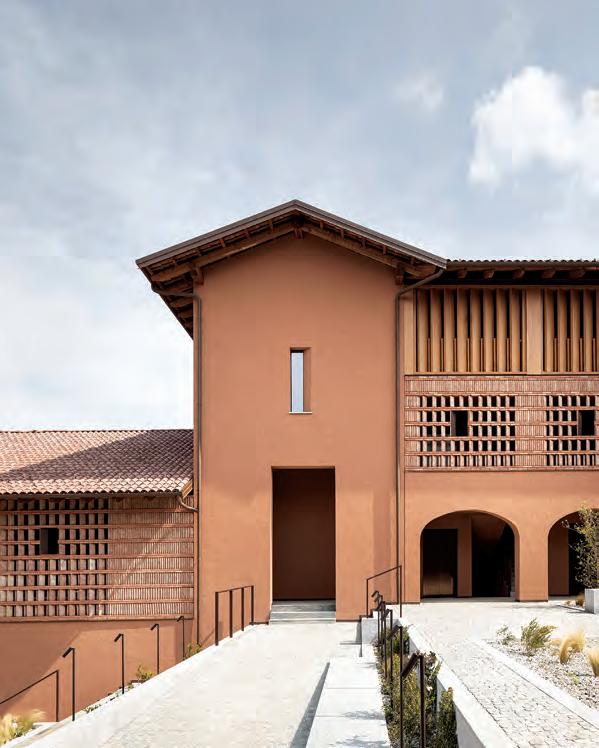
Italy’s Piedmont became a UNESCO World Heritage site in 2014 for its fertile landscape and winemaking traditions, the latter of which date to the 5th century B.C. It’s here, in the shadow of the Alps, that the eco-conscious boutique hotel Casa di Langa provides guests with unique experiences oriented around the region’s coveted wine and white truffles. Dive into blind tastings at the hotel’s educational Wine Academy or join its chefs for a cooking class, where you’ll practice making Langa’s most delectable dishes, like a velvety tajarin pasta smothered in butter and sage. But perhaps the most unique culinary experience available at Casa di Langa is truffle foraging led by expert truffle hunters and their dogs. After unearthing delicacies in the undulant Piedmont countryside, visit the onsite Lelòse Spa, where you can try the Finnish sauna and infinity pool, get a treatment or take a private yoga or Pilates class. casadilanga.com




At the wellness-oriented Aman Venice, Eastern healing philosophies meld with Italian spa traditions, culminating in a spa menu that spans everything from Thai massage to thermal wraps using salts and clays from the town of Salsomaggiore Terme. For the ultimate easy Sunday in the Floating City, book the hotel’s Brunch and Spa experience, which begins with a spread of Italian delicacies served in the opulent Arva dining room, followed by a massage incorporating reflexology and energy work. Top off your stay with an exclusive six-course tasting menu and wine pairing hosted by consultant chef Norbert Niederkofler, whose eco-conscious approach to cooking won him a Michelin green star in 2020. aman.com

The ultimate easy Sunday in the Floating City begins with a spread of Italian delicacies in the opulent Arva dining room.
Borgo Santo Pietro was once a stopover offering rest and recuperation to pilgrims walking the famous Via Francigena route from Canterbury, England, to the Holy Land. Today, that spirit of hospitality and wellbeing still permeates the 300-acre estate, which includes a 20-room boutique hotel, luxury spa and farm-to-plate culinary concept. An organic farm, vineyards and on-site dairy provide ingredients for the hotel’s Michelin-starred restaurant and lauded cooking school, which offers workshops and classes rooted in Tuscan cuisine. Herbs, flowers and honey harvested from the estate’s “medicinal gardens” are used by the hotel’s spa and beauty laboratory, which produces an exclusive, all-natural skincare collection called Seed to Skin. borgosantopietro.com

Nestled among olive trees in Salento, Puglia, Baglioni Masseria Muzza offers laidback luxury in one of Italy’s most beloved destinations. Though the hotel has three great Mediterranean restaurants, it’s the off-site experiences that stand out. On a day trip to Alberobello—home to traditional trulli stone houses—you’ll hand-make fresh mozzarella and burrata with an artisanal cheesemaker. Back at Baglioni Masseria Muzza, head to the calming, white-washed spa for hot-cold water circuits and a range of treatments and wellness rituals such as the Salt & Butter, a massage and skin exfoliation that makes an ideal first-day-ofvacation treat. baglionihotels.com



Warren Stephens grew up watching his late father, Jackson T. Stephens, fall in love with golf. In time, he’d take up the game himself, though it remained only a casual pursuit until he graduated from college. Today, Stephens’ deep ties to the sport range from owning the Alotian Club in Roland, Arkansas, to being a member of Augusta National—where his father served as chairman from 1991 to 1998. Stephens has also continued another family tradition as the chairman, president and CEO of Stephens Inc., a privately owned diversified financial services firm in Little Rock. We sat down with the 66-year-old businessman to hear how he, like his father, developed a love of the game.
What drew you to golf as a child?
My parents divorced when I was 12 or 13, and golf was something my dad and I could do together. When I would come visit in the summers, he would just make his regular Saturday group at the Country Club of Little Rock a fivesome. I would play with him and all of his friends, and it was so much fun for me to get to know those older gentlemen—they really were gentlemen—and to be around him and to see how they all teased each other and gave each other the needle. Having been in that group with my dad’s friends for his regular game, I felt like I knew how to behave on the golf course and how to behave around older people. So it was a great life lesson in that regard.
What do you love most about the game now?

The camaraderie of the people I play with. It’s really true, you get to know people on the golf course. It’s a great social interaction with other people.
Did your father coach you or give you advice on the course?

One time, when I was a kid and I was getting upset with my golf game, he said to me, ‘Well, son, you don’t have any right to be upset with your golf game.’ I said, ‘What do you mean?’ And he replied, ‘Well, you don’t practice, son. Golf requires practice, and you’re going to have to commit some time to practicing.’ I didn’t have the time for it then. Now I actually do, but now I’m so old that it doesn’t really make that much difference!

What brought you back to golf after you finished school?
It was about the only sport I had left! Everything else had moved on. I don’t remember exactly when it was—probably in the early ’90s—I thought, ‘I need to get focused on this.’ We had a corporate membership at a new club here in town called Chenal Country Club, so I went out and started taking lessons on a regular basis from the director of golf there. I got my handicap down to about a six, and it’s amazing how much more fun golf is when you can hit it with consistency.
You built the Alotian Club from the ground up, commissioning Tom Fazio to design the course. What was that experience like?
I found it to be one of the most exciting, fun things I’ve ever done. We bought the land from a timber company, and all the pine trees were pretty mature, and just to see a golf course take shape out of a big wooded area, to see that transformation was really something. It turned out better than I even hoped it would. There are not many things you can do and say after
you’re finished doing it—like building a golf course—‘Wow, we’ve made this prettier and more people get to enjoy it.’ If we didn’t buy the land for Alotian, the timber company was going to clear cut it and then they’d plant it and clear cut it again in 20 years and nobody would even know it was there.
Where did you look for inspiration for the club?
Augusta National had a big influence on the design of the golf course. My dad told me years ago that the secret to Augusta National for its members is that every member feels like they could par every hole out there—at least that they had a chance to—if they hit good shots from whatever tees they were playing from. I mentioned that to [Tom] Fazio, and he said, ‘I know exactly what you’re talking about. And we can do that.’ Alotian has wide fairways, so it looks pretty inviting off the tee. You’re not up there shaking because you’ve got a narrow opening and you need to carry it 220 yards to reach the fairway. We don’t have any of that. That’s not a course that I wanted to play every day.
Getting to play the second nine at Augusta National in late afternoon, when the shadows are out. When you get around to holes 12 and 13 and 15 and 16… it’s just a spiritual moment, really. In those moments, I find myself thinking, ‘This is where some of the greatest shots in the history of the game have been played and a lot of them around this time of day.’ If you’re fortunate enough to get to do that, you’ll never, ever forget it. I also love being at Alotian late in the afternoon, particularly in the summer. The heat of the day is gone, and with the softness of the light, it’s incredibly peaceful. That’s one of the great things about golf in general—it is peaceful.

You also created the Jackson T. Stephens Cup—a collegiate golf tournament named in your father’s honor. What aspect of that tournament brings you the most joy?
This is only our third year coming up, but to see these young people play and experience Seminole Golf Club in our second year… it’s something that most of them would never get to do. We’re giving those golfers the experience to be around these great clubs and each other. That’s a really great thing, and I’m very excited about that.
What’s the best piece of golf advice you can offer other amateur players? Sometimes you just have to remember that this isn’t my living. This is something that I’m doing for fun. If I hit a good shot, I’m going to enjoy it more than if I hit a bad shot; but if I hit a bad shot, I’m not going to let it spoil the moment for me. Every time I go to a great club and play, I often think, ‘How lucky am I?’ I’m extremely fortunate to be able to do that, and I try not to take it for granted.

My favorite summer destination is wherever I happen to be going, and this year that’s Thailand. I’ll be traveling with my family from Bangkok to Chiang Rai to Phuket, getting the full city, jungle and island experience. We’ll be staying at Anantara hotels along the way, highlighted by the famous Anantara Golden Triangle Elephant Camp & Resort along the Mekong River, near the borders with Laos and Myanmar.
—Bruce WallinI will not qualify for the America’s Cup anytime soon, but I still covet the new Rolex Oyster Perpetual Yacht-Master 42 in RLX titanium. Its luxurious appearance belies its light weight, making it the perfect summer timepiece for everything from a leisurely hike to an elegant dinner—and, yes, an afternoon sail.
 —Matt Squire
—Matt Squire
I am old school when it comes to taking meeting notes with proper pen and paper. I also like to keep a pristine copy of Kingdom to hand, and my Ettinger portfolio suits these purposes, allowing me to carry my pad, pen, magazine, laptop wherever I go. I love the British Racing Green color that marries beautifully with the golden tan interior. Ettinger has long been my choice for the nest leather goods, handmade in England—the only one with a Royal Warrant. —M.S.


We recently stayed at the new Gleneagles Townhouse in Edinburgh as a base for meetings and for some great golf. e sta at the hotel are both professional and friendly, the rooms are elegant and the restaurant is excellent—with plenty of other great dining options nearby. e roo op bar is the perfect spot for a pre-dinner cocktail and a nightcap, with far-reaching views of Edinburgh. —M.S.
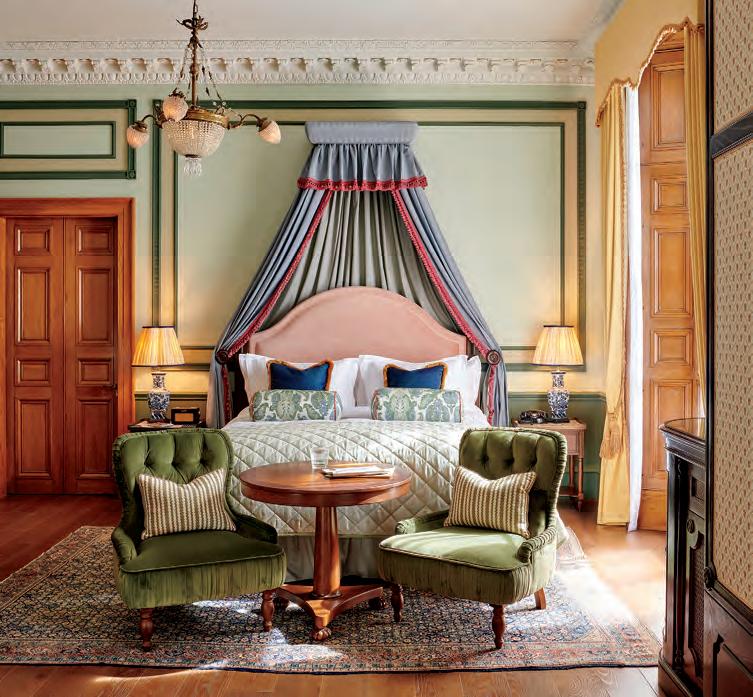
“I have started loading the new Penfold Ace golf balls on the tee, and they’re bringing distance to my drives and soft feel around the greens.”
—Jon Edwards

“The most memorable golf hole I have played recently is the 8th at the Renaissance Club in Scotland. One of Tom Doak’s greatest designs, the course runs beside ancient woodland, cliffs and drystone walls, and offers stunning views.” —M.S.

I will reach for my Campagnolo Big the Corkscrew regularly this summer. It is expertly cra ed by the Italian cycling manufacturer—whose owner claims to have invented this design, a er nding other options inadequate. Available in chrome or gold, it makes for a classy summer gi , especially for someone who appreciates cycling heritage.
 —Joe Velotta
—Joe Velotta
As temperatures rise, I savor a simple Ketel One with Fever-Tree soda and freshly squeezed lime juice. For an extra kick, I’ll drop the lime for a grapefruit wedge and fresh rosemary, of which I have an abundance growing out back. e perfect summer sipper. —M.S.

Kingdom co-founder Arnold Palmer traveled all over the world as a golfer, course architect and entrepreneur. So when it came time to take a break, the Florida resident preferred to stay close to home—but still a world away—at Little Palm Island, an adults-only, private-island resort in the Florida Keys.

I tested the XXIO Prime driver at the PGA Merchandise Show. Knowing it is designed for players with slower swing speeds, I took an easy swing and could feel the elasticity in the sha . e strike was pure, and the ball ew straight and far. is is perfect for an easyswinging summer round.
 —Shaun Tolson
—Shaun Tolson
I had been loyal to a Scotty Cameron putter since 2016; however, custom tting showed that I need a putter an inch longer than my Scotty. I tried several brands, but as soon as I picked up the Bettinardi BB46, I knew it was the one! In addition to the quality of cra smanship, the club’s compact mallet design with new graphite gray nish and white sight line really suited my eye and helped frame the ball nicely. e feel o the face is so and responsive, and my distance control is more consistent than ever—even better than with my Scotty. —M.S.

With a busy summer schedule, I love the versatility of Hedge New York. e brand fuses the elegance of a cocktail dress with the comfort of athleisure, so I can wear it on the course, in the o ce or even out at night. A favorite is the Linden Quarter Zip Sweatshirt, which can easily transition from season to season, while their Lolly Dress is attering on every body type.
 —Emily Poppert
—Emily Poppert
Vuori is my go-to clothing these days. ey make premium performance apparel inspired by the active, coastal California lifestyle—it’s a perfect balance of elevated style and comfort. As the Texas temps increase, I basically live in their Rise tee and Ripstop pants and shorts. For the golf course, check out the Aim pants. —Matt Carroll

It does not get much better than playing the Arnold Palmer–designed Victoria Golf Course (see page 26) in Portugal’s Algarve region, before heading to Izzy’s Beach Restaurant. With panoramic views of the Atlantic Ocean, a great menu and genuinely welcoming sta , this restaurant is a must. I especially enjoy the grilled squid sautéed in garlic and local olive oil, washed down with a glass (or two) of Whispering Angel rosé. —M.S.

clubs



have their own frequent flyer number, but since upgrading to the Clubglider Meridian—a travel bag with retractable front legs and pivoting wheels— transporting them has been a breeze.”

“My
should probably
—S.T.






Excitement is building for the second annual Kingdom Cup, which is taking place September 21–24 on Hilton Head Island in South Carolina. Last year’s tournament featured Kingdom readers playing alongside PGA Tour stars Davis Love III, Matt Kuchar and Cameron Young over a weekend of best-ball golf, gourmet dinners, cocktail hours, off-course adventures and good old fashioned Southern hospitality. Come September, the Kingdom crew will gather once again on Hilton Head Island for an actionpacked itinerary of great golf—including a tournament round on Arnold Palmer Design’s incredible Wexford course—and great fun. Visit kingdom.golf/cup for more information and to book your spot at the 2023 Kingdom Cup.
Wexford (above), where one of two tournament rounds will be held at this year’s Kingdom Cup. Highlights from last year’s event include (from top right): beach yoga led by Charlotte Hardwick; PGA Tour caddie Geno Bonnalie; PGA Tour Rookie of the Year Cameron Young with low gross champions Tony Loiacono and Andy Levine; Dewar’s ambassador and golf personality Roger Steele and PGA Tour pro Davis Love III; host Alexandra O’Laughlin and tennis icon Stan Smith; golfers finishing the first round.

LAST SCHOOL YEAR
9,000
SCHOLARSHIPS





UPCOMING SCHOOL YEAR
12,500


APPLICANTS
YOUR DONATION WILL HELP US FULFILL SCHOLARSHIPS FOR


30%

Last year, we awarded nearly 9,000 academic scholarships, our best year ever. We couldn't have done it without the golf community.
THIS YEAR, WE FACE AN EVEN LARGER CHALLENGE WITH OVER 30% MORE APPLICANTS — THAT'S NEARLY 12,500 CHILDREN AND SPOUSES WHO NEED YOUR HELP.
Join fellow golfers in donating to make a life-changing difference for the families of America's fallen or disabled service members and first responders.







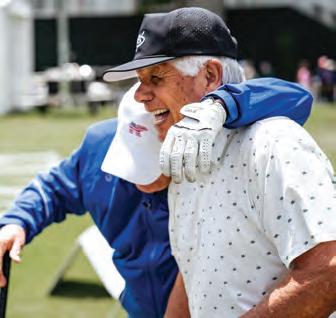

FOLDSOFHONOR.COM/GOLF
MORE APPLICANTS
DONATE TODAY
















